3D动画2013 (4)
EMC-1
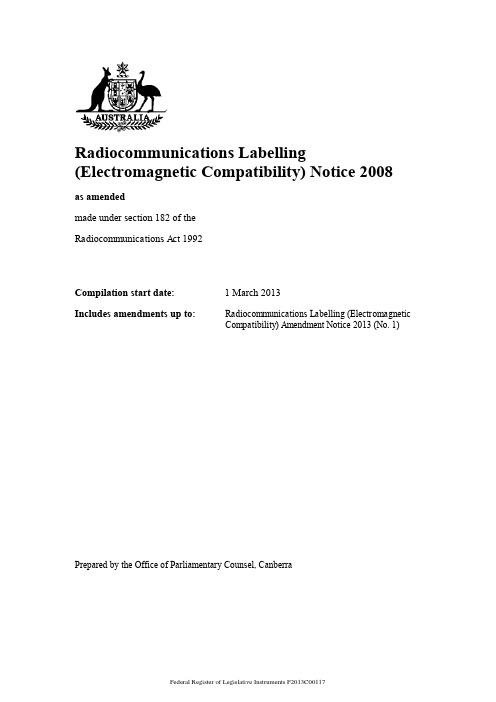
Radiocommunications Labelling (Electromagnetic Compatibility) Notice 2008 as amendedmade under section 182 of theRadiocommunications Act 1992Compilation start date: 1 March 2013Includes amendments up to: Radiocommunications Labelling (ElectromagneticCompatibility) Amendment Notice 2013 (No. 1) Prepared by the Office of Parliamentary Counsel, CanberraAbout this compilationThe compiled instrumentThis is a compilation of the Radiocommunications Labelling (Electromagnetic Compatibility) Notice 2008 as amended and in force on 1 March 2013. It includes any amendment affecting the compiled instrument to that date.This compilation was prepared on 1 March 2013.The notes at the end of this compilation (the endnotes) include information about amending Acts and instruments and the amendment history of each amended provision. Uncommenced provisions and amendmentsIf a provision of the compiled instrument is affected by an uncommenced amendment, the text of the uncommenced amendment is set out in the endnotes.Application, saving and transitional provisions for amendmentsIf the operation of an amendment is affected by an application, saving or transitional provision, the provision is set out in the endnotes.ModificationsIf a provision of the compiled instrument is affected by a textual modification that is in force, the text of the modifying provision is set out in the endnotes.Provisions ceasing to have effectIf a provision of the compiled instrument has expired or otherwise ceased to have effect in accordance with a provision of the instrument, details of the provision are set out in the endnotes.Radiocommunications Labelling (Electromagnetic Compatibility)Notice 2008iContentsPart 1—Preliminary11.1 Name of Notice 11.2 Commencement 11.3 Revocation 11.4 Definitions 11.5 Meaning of compliance records 41.6 Meaning of description of the device51.6A Meaning of medium risk device61.7 Meaning of device that complies with New Zealand labelling legislation61.8 Other interpretation 6 Part 2—Application of Notice82.1 Devices to which this Notice applies 82.2 Devices to which this Notice does not apply—general 82.3 Devices to which this Notice does not apply—New Zealand devices 82.4 Relationship between this Notice and the Telecommunications Labelling(Customer Equipment and Customer Cabling) Notice 200182.5 Relationship between this Notice and the Radiocommunications Devices(Compliance Labelling) Notice 200382.6 Devices incorporating a radiocommunications transmitter 9 Part 3—Form and placement of compliance labels103.1 Compliance labels 103.2 Compliance labels for low risk devices 113.3 Who must apply a compliance label to a device? 113.4 Durability of compliance label 113.5 Format of compliance label 123.6 Placement of compliance label 123.6A Electronic labelling 123.7 Explanatory documentation to be supplied with a device 12 Part 4—Conditions for application of compliance label144.1 Application of Part 4 144.2 Use of RCM subject to registration on national database or issue of suppliercode number 144.2A Registration on national database 144.2B Use of C-Tick mark 154.2C Issue of supplier code number 154.3 Meeting compliance levels 154.3A Declaration of conformity 164.4 Compliance level 1—low risk device 164.5 Compliance level 2—medium risk device 164.6 Compliance level 3—high risk device 164.7 Additional requirements for variants 16 Part 5—Compliance records175.1 Compliance records—general requirements 175.2 Keeping records 175.3 Availability of compliance records for inspection 175.4 Provision of information to authorised officer 175.5 Request for test reports from accredited testing body 185.6 Evidence of compliance with applicable standard under section 5.5 18 Part 6—Special requirements for supply of devices after changes toapplicable standard or this Notice196.1 Devices labelled with a compliance label before this Notice 196.2 Changes to an applicable standard 196.3 Transitional—devices to which IEC, CISPR or AS/NZS standards apply 196.4 Transitional—devices to which EN standard applies 20 Part 7—Requirements to be met after labels applied—devices imported from New Zealand217.1 Purpose of Part 7 217.2 Provision of information to authorised officer 21 Schedule 1—Technical standards22 Schedule 2—Devices to which this Notice does not apply23 Schedule 3—Compliance marks25 Part 1—The C-Tick mark25 Part 2—The RCM26 Endnotes 27 Endnote 1—Legislation history27 Endnote 2—Amendment history28 Endnote 3—Application, saving and transitional provisions30 Endnote 4—Uncommenced amendments31 Endnote 5—Misdescribed amendments32ii Radiocommunications Labelling (Electromagnetic Compatibility)Notice 2008Preliminary Part 1Section 1.1Radiocommunications Labelling (Electromagnetic Compatibility)Notice 20081Part 1—Preliminary1.1 Name of NoticeThis Notice is the Radiocommunications Labelling (ElectromagneticCompatibility) Notice 2008.Note: The predecessor to this Notice was the Radiocommunications (Compliance Labelling—Incidental Emissions) Notice 2001, which is revoked by section 1.3 of this Notice. 1.2 CommencementThis Notice commences on the day after it is registered.1.3 RevocationThe Radiocommunications (Compliance Labelling—Incidental Emissions)Notice 2001, made on 2 November 2001, is revoked.1.4 DefinitionsIn this Notice:accredited, in relation to a test report, means a report that was produced by thefollowing process:(a) the test was conducted by an accredited testing body;(b) the test was conducted against an applicable standard;(c) at the time the test was conducted, the applicable standard was within theterms of the accredited testing body’s accreditation, designation,notification or recognition.accredited testing body means a laboratory:(a) that is a testing body; and(b) that is:(i) accredited by NATA to conduct testing against an applicablestandard; or(ii) accredited, by a body that has entered into a mutual recognitionagreement with NATA, to conduct testing against an applicablestandard; or(iii) designated, notified or recognised, under an agreement about mutualrecognition on conformity assessment to which Australia is a party, toconduct testing against an applicable standard.Act means the Radiocommunications Act 1992.agent, of a manufacturer or importer, means a person who is authorised inwriting by the manufacturer or importer to act in Australia as an agent of themanufacturer or importer for Division 7 of Part 4.1 of the Act.Part 1 PreliminarySection 1.4applicable standard, in relation to a device, means any of the followingstandards insofar as those standards relate to interference toradiocommunications or to any uses or functions of devices:(a) a standard referenced for the device in the Radiocommunications(Electromagnetic Compatibility) Standard 2008;(b) a standard mentioned in the table in Schedule 1.Note: The list of applicable standards may be found at the website address.au/standards/emc.AS/NZS, in relation to the prefix of a document, has the meaning given bysubsection 1.8(1).AS/NZS 4417.1 means the Australian/New Zealand Standard Marking ofelectrical and electronic products to indicate compliance with regulations—Part 1: General rules for use of the mark published by Standards Australia.authorised officer means:(a) an inspector under subsection 267(1) of the Act; or(b) a person authorised in writing by ACMA for this Notice.battery-powered device means a device that is not capable of being connected,directly or indirectly, to an external power supply.built-in display, for a device, means an electronic display or screen integral tothe device, and does not include a display or screen that can be usedindependently of the device.CISPR, in relation to the prefix of a document, has the meaning given bysubsection 1.8(3).competent body means a body accredited by NATA under subsection 183(3) ofthe Act.compliance label means a label that complies with the requirements mentionedin Part 3.Note: Section 2.4 extends some references to ‘compliance label’ in this Notice to include acompliance label under the Telecommunications Labelling (Customer Equipment andCustomer Cabling) Notice 2001.compliance mark means any of the marks mentioned in Schedule 3.compliance records has the meaning given by section 1.5.C-Tick mark means the mark set out in Part 1 of Schedule 3.declaration of conformity means a declaration that:(a) is in a form approved by the ACMA; or(b) contains the information required in that approved form, whether or not thedeclaration is accompanied by other material.Note: The ACMA makes approved forms available on its website at.au/complianceforms.2Radiocommunications Labelling (Electromagnetic Compatibility)Notice 2008Preliminary Part 1Section 1.4Radiocommunications Labelling (Electromagnetic Compatibility)Notice 20083description of the device has the meaning given by section 1.6.device has the meaning given by subsection 9(1) of the Act.device that complies with New Zealand labelling legislation has the meaning given by section 1.7.EN, in relation to the prefix of a document, has the meaning given by subsection 1.8(4).fixed installation means a particular combination of 1 or more devices that is assembled, installed and intended to be used permanently at a predetermined location.high risk device means a device described as ‘Group 2 ISM equipment’ inAS/NZS CISPR 11:2004 (2nd Edition).IEC, in relation to the prefix of a document, has the meaning given by subsection 1.8(2).low risk device means a device that is neither:(a) a medium risk device; nor(b) a high risk device.medium risk device has the meaning given by section 1.6A.NATA means the National Association of Testing Authorities, Australia. national database means a database designated in writing by the ACMA for the purposes of Part 4.Note: A database may be designated by the ACMA for the purposes of Part 4 even if it forms part of another database or also serves purposes other than purposes provided for in thisNotice.New Zealand labelling legislation means:(a) the Radiocommunications (EMC Standards) Notice 2004 (No. 2) of NewZealand; and(b) the Radiocommunications (Radio Standards) Notice 2007 of New Zealand; as in force from time to time.RCM means the Regulatory Compliance Mark set out in Part 2 of Schedule 3. supplier, in relation to a device, means a person in Australia who is:(a) the manufacturer or the importer of the device; or(b) an agent of the manufacturer or importer of the device.supplier code number means a code number issued to a person:(a) in accordance with a notice made by ACMA under section 407 of theTelecommunications Act 1997; or(b) in accordance with a notice made by ACMA under section 182 of the Act;orPart 1 PreliminarySection 1.54Radiocommunications Labelling (Electromagnetic Compatibility)Notice 2008(c) by Standards Australia International Limited, in accordance with AS/NZS4417.1. technical construction file means documentary material in English that includes a report produced by a competent body assessing a device against the requirements of an applicable standard, in which the report: (a) identifies the device assessed; and(b) identifies the applicable standard against which the device was assessed;and(c) includes a statement by the competent body stating that, in the opinion ofthe competent body, the device complies with the applicable standard. test report means a report in English produced by a testing body or an accredited testing body assessing a device against the requirements of an applicable standard, that:(a) identifies the device tested; and(b) identifies the applicable standard against which the assessment was made;and(c) includes a statement by the testing body or accredited testing body statingthat the device complies with each relevant requirement of the applicable standard. testing body means a laboratory that has the equipment, resources and technical capability to conduct testing to an applicable standard.variant means a version of a device that is not identical to the original device but is not sufficiently different from the original device to affect the application to that version of a standard that applies to the original device.working day , in relation to a request, means a day other than: (a) a Saturday or a Sunday; or(b) a day that is a public holiday or an Australian Public Service holiday in theplace where the request is made.1.5 Meaning of compliance recordsIn this Notice, the compliance records for a kind of device are mentioned in the table.Item For this device ... these are the compliance records ...1a device other than a low risk device or a variant(a) a description of the device; and (b) a declaration of conformity; and(c) a test report or a technical construction file; and(d) for a device to which a compliance label is not applied because of section 3.6—the records mentioned in subsection 3.6(3); and(e) a copy of any explanatory documentation required by section 3.7Preliminary Part 1Section 1.6Radiocommunications Labelling (Electromagnetic Compatibility)Notice 20085Item For this device ... these are the compliance records ...2 a low risk device that hasnot been labelled or hasbeen labelled otherwisethan as required orprovided for by this Noticea description of the device3 a low risk device that hasbeen labelled as requiredor provided for by thisNotice (a) a description of the device; and(b) a declaration of conformity4 a variant of a device otherthan a low risk device (a) a description of the variant; and(b) a declaration of conformity that relates to the variant; and(c) a test report or a technical construction file for the originaldevice; and(d) for a device to which a compliance label is not appliedbecause of section 3.6—the records mentioned insubsection 3.6(3); and(e) a statement by the supplier about the variant that ismentioned in subsection 4.7(2)5 a variant of a low riskdevice that has not beenlabelled or has beenlabelled otherwise than asrequired or provided for bythis Noticea description of the variant6 a variant of a low riskdevice that has beenlabelled as required orprovided for by this Notice (a) a description of the variant; and(b) a declaration of conformity that relates to the variantNote: Items 3 and 6 of the above table do not apply to a device if that device is labelled solely to comply with State or Territory electrical safety legislation and is not required to beara compliance label by this Notice.1.6 Meaning of description of the deviceIn this Notice, a description of the device must contain sufficient information fora person to determine whether the device is the same as a device for which adeclaration of conformity, test report or statement by a competent body wasprepared, and:(a) must include the model number for the device and, if relevant, any relatedmodel numbers for the device; and(b) must include the version of any software or firmware incorporated into orsupplied with the device where changes in that software or firmware mayaffect compliance with the applicable standard; and(c) may include a photograph, or photographs, of the device showing thedevice’s internal and external aspects (including the printed circuit boards).Part 1 PreliminarySection 1.6A1.6A Meaning of medium risk device(1) In this Notice, subject to subsection (2), a device is a medium risk device if it isnot a high risk device and contains 1 or more of the following:(a) a switch mode power supply;(b) a transistor switching circuit;(c) a microprocessor;(d) a commutator;(e) a slip-ring motor;(f) an electronic device operating in a switching mode or a non-linear mode.(2) A battery-powered device is not a medium risk device unless the ACMA hasdeclared the device to be a medium risk device under subsection (3).(3) The ACMA may declare, in writing, that a particular battery-powered devicespecified in the declaration is a medium risk device if:(a) the common operation of the device causes radio emissions; and(b) those radio emissions have caused, or are likely to cause, interference,disruption or disturbance to other devices or to radiocommunicationsservices; and(c) the device is not a high risk device.(4) A declaration under subsection (3) is not a legislative instrument for thepurposes of the Legislative Instruments Act 2003.1.7 Meaning of device that complies with New Zealand labelling legislationIn this Notice, a device that complies with New Zealand labelling legislation isa device that bears a New Zealand compliance mark in accordance with the NewZealand labelling legislation.1.8 Other interpretation(1) A reference in this Notice to a document with the prefix ‘AS/NZS’ is a referenceto a document that is a joint Australian and New Zealand Standard approved forpublication on behalf of the Standards organisations of those countries.(2) A reference in this Notice to a document with the prefix ‘IEC’ is a reference to adocument that is an International Electrotechnical Commission Standardapproved for publication.(3) A reference in this Notice to a document with the prefix ‘CISPR’ is a referenceto a document that is an International Special Committee on Radio InterferenceStandard approved for publication.(4) A reference in this Notice to a document with the prefix ‘EN’ is a reference to adocument that is a European Committee for Electrotechnical StandardizationStandard approved for publication.6Radiocommunications Labelling (Electromagnetic Compatibility)Notice 2008Preliminary Part 1Section 1.8Radiocommunications Labelling (Electromagnetic Compatibility)Notice 20087(5) Reference may be made in this Notice to a standard mentioned in this section bynumber alone without inclusion of the edition or year of publication of thestandard.Examples1 AS/NZS 4417.1:1996 may be referred to as AS/NZS 4417.1.2 CISPR 22:2005 may be referred to as CISPR 22.Part 2 Application of NoticeSection 2.1Part 2—Application of Notice2.1 Devices to which this Notice appliesThis Notice applies to a device:(a) that is:(i) manufactured in Australia; or(ii) imported into Australia;for supply in Australia; and(b) to which an applicable standard applies.Note: Section 5 of the Act contains the following definition:supply includes supply (including re-supply) by way of sale, exchange, lease, hire orhire-purchase.2.2 Devices to which this Notice does not apply—generalThis Notice does not apply to a device that is mentioned in Schedule 2.2.3 Devices to which this Notice does not apply—New Zealand devicesParts 3, 4 and 5 of this Notice do not apply to a device that:(a) is imported into Australia from New Zealand for supply; and(b) is a device that complies with New Zealand labelling legislation.Note 1: The effect of this section is to exempt the devices from the labelling requirements ofthis Notice.Note 2: Section 1.7 explains when a device is a device that complies with New Zealandlabelling legislation.2.4 Relationship between this Notice and the Telecommunications Labelling(Customer Equipment and Customer Cabling) Notice 2001If a device to which this Notice applies is also customer equipment or customercabling to which the Telecommunications Labelling (Customer Equipment andCustomer Cabling) Notice 2001, as in force from time to time, applies:(a) the requirements in this Notice are additional to the requirements under thatNotice; and(b) Part 3 of this Notice does not apply in relation to the device; and(c) a reference in this Notice (except section 1.4) to a compliance labelincludes a reference to a compliance label under that Notice.2.5 Relationship between this Notice and the Radiocommunications Devices(Compliance Labelling) Notice 2003If a device to which this Notice applies contains a device, or incorporates adevice to which the Radiocommunications Devices (Compliance Labelling)8Radiocommunications Labelling (Electromagnetic Compatibility)Notice 2008Application of Notice Part 2Section 2.6Radiocommunications Labelling (Electromagnetic Compatibility)Notice 20089Notice 2003, as in force from time to time, applies, the requirements in thisNotice are additional to the requirements in that Notice.Note: An effect of section 2.5 is that a compliance mark can only be applied to a device if the device complies with the requirements of this Notice and the RadiocommunicationsDevices (Compliance Labelling) Notice 2003.2.6 Devices incorporating a radiocommunications transmitter(1) If a device (a parent device) contains or incorporates a radiocommunicationstransmitter, the transmitter must be switched off, or placed in an idle state, beforethe parent device is assessed for compliance against this Notice.Note: Subsection 7(2) of the Act contains the definition of radiocommunications transmitter.(2) For the avoidance of doubt, if a parent device contains or incorporates aradiocommunications transmitter, the transmitter need not comply with thisNotice.Part 3 Form and placement of compliance labelsSection 3.1Part 3—Form and placement of compliance labels3.1 Compliance labelsRequirement for devices (other than low risk devices) to bear compliance label(1) If an applicable standard applies to a device that is not a low risk device, and thedevice complies with the standard, the device must bear a compliance label,consisting of either:(a) the RCM; or(b) if the label is applied before 1 March 2016—either of the compliancemarks.Note 1: The effect of section 4.2 is that a supplier must not apply a compliance label, consisting of the RCM to a device unless:(a) the supplier is registered on the national database; or(b) if the ACMA has not designated in writing a national database for the purposes ofPart 4—the supplier has been issued a supplier code number.Note 2: The effect of section 4.2B is that a supplier must not apply a compliance label,consisting of the C-Tick mark to a device unless the supplier has been issued a suppliercode number by the ACMA. In accordance with section 4.2C, the ACMA will ceaseissuing supplier code numbers at the time the ACMA designates in writing a nationaldatabase.Note 3: The effect of section 2.3 is to exempt a device that:(a) is imported into Australia from New Zealand for supply; and(b) bears a New Zealand compliance mark that complies with New Zealand labellinglegislation,from the requirement for the device to bear a compliance label.Note 4: Section 3.2 deals with the relationship between low risk devices and the labellingobligations. Suppliers must meet the same compliance level and record-keepingobligations in relation to low risk devices even if a compliance label has not beenapplied to the device.Note 5: A device that does not comply with an applicable standard is defined bysubsection 9(2) of the Act to be a non-standard device, and is regulated underDivision 2 of Part 4.1 of the Act.Note 6: Paragraph 2.4(b) provides that Part 3 of this Notice does not apply in relation to adevice to which the Telecommunications Labelling (Customer Equipment andCustomer Cabling) Notice 2001 applies. Consequently, a device that is to be labelledwith an A-Tick mark under the Telecommunications Labelling (Customer Equipmentand Customer Cabling) Notice 2001 before 1 March 2016 is not required to be labelledwith a compliance mark under this Notice.Location of compliance label(2) Subject to sections 3.6 and 3.6A, the compliance label must be placed on thedevice on a place that is accessible by the user.Note: Section 3.6 deals with situations where applying a label to the surface of a device is not possible or practicable. Section 3.6A gives a supplier the option of labelling some typesof devices electronically.10Radiocommunications Labelling (Electromagnetic Compatibility)Notice 2008Form and placement of compliance labels Part 3Section 3.2Radiocommunications Labelling (Electromagnetic Compatibility)Notice 200811(3) A label is not accessible if it is necessary to use a specialised tool to gain accessto it.3.2 Compliance labels for low risk devices(1) The supplier of a low risk device may choose whether or not to apply acompliance label to the device.Note: Section 4.2 applies to a supplier that chooses to apply a compliance label to a low risk device.(2) A low risk device must comply with an applicable standard that is applicable toit, whether or not it has a compliance label applied to it.(3) If a supplier chooses not to apply a compliance label to a low risk device then,for the application of the following provisions of this Notice, the low risk deviceis taken to have a compliance label applied to it:(a) section 3.7;(b) Part 4 (other than section 4.3A);(c) Part 5.Note: The effect of applying these provisions to a low risk device is to require the supplier to comply with record-keeping obligations, whether or not the low risk device has acompliance label applied to it.3.3 Who must apply a compliance label to a device?(1) If a device that is required to have a compliance label attached is manufacturedin Australia, the compliance label must be applied to the device by:(a) the manufacturer; or(b) an agent of the manufacturer; or(c) a person who is authorised by the manufacturer or agent to apply the labelor mark on behalf of the manufacturer or agent.(2) If a device that is required to have a compliance label attached is manufacturedoutside Australia, the compliance label must be applied to the device by:(a) the importer; or(b) an agent of the importer; or(c) a person who is authorised by the importer or agent to apply the label ormark on behalf of the importer or agent.3.4 Durability of compliance label(1) A compliance label must be durable.(2) A compliance label must be applied to a device:(a) permanently; or(b) in a way that makes removal or obliteration difficult.Part 3 Form and placement of compliance labelsSection 3.53.5 Format of compliance labelA compliance mark must be at least 3 mm high.Note: This Notice does not prevent a supplier from applying its own additional supplieridentification details onto a device.3.6 Placement of compliance label(1) If it is not possible to apply a compliance label to the surface of a device becauseof the size or physical nature of the device, or it is not practical to apply acompliance label to the surface of a device, the compliance label must be appliedto:(a) the external surface of the packaging used for the device; and(b) the documentation (including any warranty or guarantee certificates) thataccompanies the device when it is supplied to the user.(2) The compliance label applied to the external surface of the packaging used forthe device must:(a) occupy an area that is greater than 1% of that external surface; and(b) be clearly visible.(3) The supplier must make and keep a record of:(a) the reasons why subsection (1) applies to the device; and(b) where each compliance label is applied.3.6A Electronic labelling(1) A supplier may apply a compliance label to a device using the built-in display ofthe device.(2) The supplier must ensure that the documentation that accompanies the devicewhen it is supplied to the user sets out a method for displaying the compliancelabel.(3) The compliance label must be applied to the device in a way that would make itdifficult to prevent the display of the label when the method set out in thedocumentation is used.(4) Subsection 3.1(2) and sections 3.4 and 3.6 do not apply to a label applied underthis section.3.7 Explanatory documentation to be supplied with a deviceIf it is possible for a device to be installed or operated incorrectly, to the extentthat the device will be used in a way that the device does not comply with anapplicable standard for the device, the supplier of the device must supplydocumentation with the device that sets out specifications for correct installationand operation to minimise that possibility.Example12Radiocommunications Labelling (Electromagnetic Compatibility)Notice 2008。
杜比数字影院系统用户手册

76杜比数字影院播放系统用户手册插图目录图11杜比数字影院网络图21杜比数字影院存储器前面板图22将移动硬盘插入数字影院存储器图23插入数字影院存储器的移动硬盘图24当出现闪烁的红色硬盘图标时请勿拨出硬盘图25将移动硬盘从数字影院存储器插槽中拨出图26杜比数字影院存储器后面板图27杜比数字影院的处理器前面板图28杜比数字影院的处理器后面板图31数字影院的处理器菜单栏图标图32将包含拟播放内容的移动硬盘插入数字影院存储器中图33使用数字影院的处理器上载内容图34上载选定内容的数字证书图35选定影片播放图36启动中或尚未与数字影院的处理器连接时的监视器屏幕图37选择放映序列或单一影片时的监视器屏幕图38内容菜单选择内容图39禁止自动键以选择内容图310内容菜单选择某一放映序列图311没有数字证书的影片呈红色图312没有得到正确数字证书的影片图313放映序列中包含未得到正确数字证书的影片图314数字证书的弹出信息图315为手动播放做好准备图316监视屏放映过程中图317暂停放映图318停止放映图319内容菜单上载内容图320数字影院存储器中可播放的影片图321上载内容确认菜单图322上载内容进度条图323内容菜单删除内容图324从数字影院存储器硬盘上删除内容图325删除内容确认菜单图326要删除的影片是放映序列的一部分图327内容菜单卸载内容图328内容菜单上载数字证书图329上载数字证书时的屏幕图330影片排期表菜单今日放映图331影片排期表菜单无可用的影片排期表图332状态菜单所有参数均正常图333视频状态菜单图334音频状态菜单杜比数字影院播放系统用户手册图335放映厅状态菜单图336数字影院的处理器系统状态菜单图337数字影院存储器状态菜单图338设置菜单图339亮度设置菜单图340时间格式设置菜单图341视频参考设置菜单图342播放模式菜单图343时间码输出菜单图344时间码偏移菜单图345视频播放速率设置菜单图346将播放模式从2d切换为3d图41标明数字影院存储器出现故障的硬盘图42移除数字影院存储器前面板图43移除数字影院存储器支架图44移除数字影院存储器的故障硬盘图45将替换硬盘插入数字影院存储器中图46重新安装数字影院存储器支架图47重新安装数字影院存储器前面板图48数字影院存储器前面板电源指示灯图49后面板上的故障电源图410关闭蜂鸣器并断开交流电源图411卸下固定夹图412卸除故障电源图413插
3dsmax2024动画技术初学者基础训练教程(2024)

17
针对在材质设置过程中 可能遇到的问题,提供
解决方案和建议。
04
灯光与摄影机初级设 置
2024/1/30
18
标准灯光类型及属性设置
目标聚光灯
模拟聚光灯效果,具有方向性和 范围限制,适用于局部照明。
属性设置
调整灯光颜色、强度、衰减等。
自由聚光灯
无目标点的聚光灯,可自由变换 照射角度。
属性设置
2024/1/30
V-Ray渲染器
专业的物理渲染引擎,可实现 高质量的图像和动画渲染。
Arnold渲染器
基于物理的渲染引擎,适用于 电影级视觉效果制作。
设置方法
在3ds Max中,可以通过“渲 染设置”对话框选择不同的渲 染器,并进行相关参数设置。
29
渲染输出参数设置
01
输出大小
根据需要设置渲染图像的大小,通 常以像素为单位。
2024/1/30
添加特效
使用辉光、景深、运动模糊等特效增强图像 视觉效果。
输出格式
根据需要选择合适的输出格式,如JPEG、 PNG、TIFF等。
31
实例:静帧作品渲染输出及后期处理
创建静帧场景
在3ds Max中创建一个静帧场景,包 括模型、材质、灯光等元素。
渲染输出
使用合适的渲染器和参数设置进行渲 染输出。
2024/1/30
后期处理
在图像处理软件中对渲染输出的图像 进行色彩调整、特效添加等后期处理 操作。
最终输出
将处理后的图像保存为合适的格式, 完成静帧作品的制作。
32
THANKS
感谢观看
2024/1/30
33
24
动画控制器使用方法
[30万高品质城市SUV推荐大全]高品质3d里番推荐
![[30万高品质城市SUV推荐大全]高品质3d里番推荐](https://img.taocdn.com/s3/m/dd972cd0c0c708a1284ac850ad02de80d4d806a9.png)
[30万高品质城市SUV推荐大全]高品质3d里番推荐厂商指导价:22.98-33.48万元从外观设计来看,换代森林人引入了斯巴鲁新家族风格并借鉴了许多来自翼豹、力狮和某V的设计元素。
健壮的车头拥有新家族风格的进气格栅,头灯轮廓更锐利,外扩的前后轮拱以及突出的裙边线条则构成了极具力量感的车身。
白色的森林人某T2.0T运动版车型的前脸则更为夸张,前保险杠两侧犹如被利刃割裂开来,视觉效果更为激进凶猛,增加的镀铬装饰条则提升了豪华尊贵感。
新森林人车身尺寸得到全面提升,整车的长宽高分别为4595/1795/1695mm,分别比现款车型增加了35mm、15mm和20mm。
轴距当然也同步提升,从现款车型的2615mm增加到2640mm,车内乘坐空间变得更大,宽大而平整的行李箱容积也提高到505L,完全能够胜任一次长途旅行的装载要求。
新车内饰给人规整、简单的印象,但略显平淡了一些。
原先斯巴鲁专注于车辆的机械性能和动力底盘表现而忽视人员的触觉感受,在丰田入主后,斯巴鲁也开始注重人性化方面的细节提升。
黑色内饰简单的辅以银色铝质感饰条进行装饰。
空调出风口由现款车型的中央显示屏下方移到了上方,中控台顶部的行车电脑显示屏幕经过升级屏幕尺寸更大,信息显示更丰富,阅读起来也更方便。
镂空设计、带拨片的三辐条方向盘和铝合金踏板倒是内饰不多的亮点设计。
动力方面,全新森林人将提供水平对置四缸2.0升自然吸气和2.0T 双涡轮增压两款发动机,最大输出功率分别为146p和276p,2.0T动力竟比2.0L自然吸气发动机提升将近一倍!此外,针对美国市场和欧洲还有2.5升排量水平对置四缸汽油发动机,最大马力173p以及一台150p的2.0升柴油发动机。
厂商指导价:22.98-34.48万元全新欧蓝德源自P某-MiEVII概念车造型设计理念,平直、狭长的进气格栅相比老款车型有了很大改变,更显犀利,和两侧的头灯融合自然,底部的两个圆形雾灯带有镀铬装饰,显得极为时尚。
3D知识大集合,3D影片集合,3d电影资源分享!
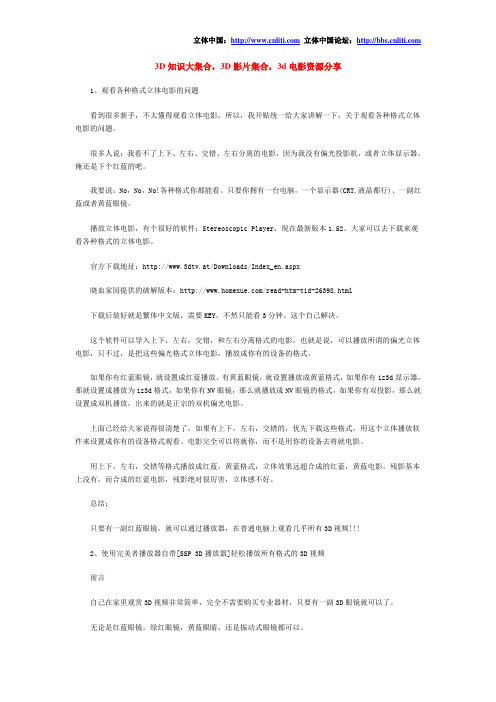
3D知识大集合,3D影片集合,3d电影资源分享1、观看各种格式立体电影的问题看到很多新手,不太懂得观看立体电影,所以,我开贴统一给大家讲解一下,关于观看各种格式立体电影的问题。
很多人说:我看不了上下、左右、交错、左右分离的电影,因为我没有偏光投影机,或者立体显示器。
俺还是下个红蓝的吧。
我要说:No,No,No!各种格式你都能看。
只要你拥有一台电脑,一个显示器(CRT,液晶都行)、一副红蓝或者黄蓝眼镜。
播放立体电影,有个很好的软件:Stereoscopic Player,现在最新版本1.52。
大家可以去下载来观看各种格式的立体电影。
官方下载地址:http://www.3dtv.at/Downloads/Index_en.aspx晓血家园提供的破解版本:/read-htm-tid-26398.html下载后装好就是繁体中文版,需要KEY,不然只能看3分钟。
这个自己解决。
这个软件可以导入上下,左右,交错,和左右分离格式的电影,也就是说,可以播放所谓的偏光立体电影,只不过,是把这些偏光格式立体电影,播放成你有的设备的格式。
如果你有红蓝眼镜,就设置成红蓝播放,有黄蓝眼镜,就设置播放成黄蓝格式,如果你有iz3d显示器,那就设置成播放为iz3d格式,如果你有NV眼镜,那么就播放成NV眼镜的格式,如果你有双投影,那么就设置成双机播放,出来的就是正宗的双机偏光电影。
上面已经给大家说得很清楚了,如果有上下,左右,交错的,优先下载这些格式,用这个立体播放软件来设置成你有的设备格式观看。
电影完全可以将就你,而不是用你的设备去将就电影。
用上下,左右,交错等格式播放成红蓝,黄蓝格式,立体效果远超合成的红蓝,黄蓝电影,残影基本上没有,而合成的红蓝电影,残影绝对很厉害,立体感不好。
总结:只要有一副红蓝眼镜,就可以通过播放器,在普通电脑上观看几乎所有3D视频!!!2、使用完美者播放器自带[SSP 3D播放器]轻松播放所有格式的3D视频前言自己在家里观赏3D视频非常简单,完全不需要购买专业器材,只要有一副3D眼镜就可以了。
原画师招聘笔试题及解答(某世界500强集团)
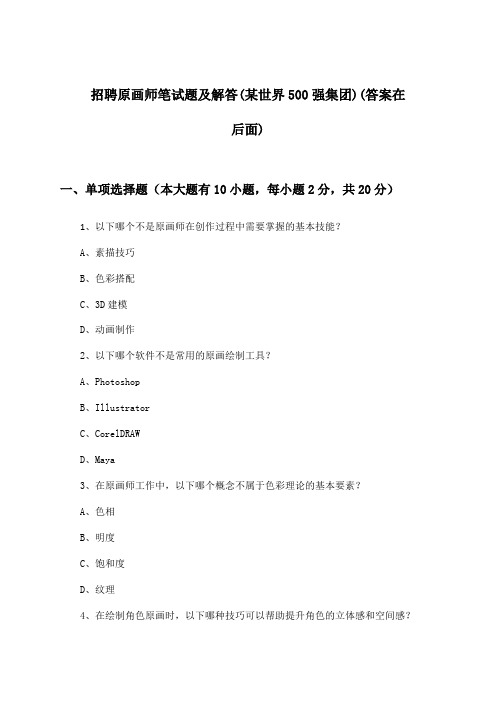
招聘原画师笔试题及解答(某世界500强集团)(答案在后面)一、单项选择题(本大题有10小题,每小题2分,共20分)1、以下哪个不是原画师在创作过程中需要掌握的基本技能?A、素描技巧B、色彩搭配C、3D建模D、动画制作2、以下哪个软件不是常用的原画绘制工具?A、PhotoshopB、IllustratorC、CorelDRAWD、Maya3、在原画师工作中,以下哪个概念不属于色彩理论的基本要素?A、色相B、明度C、饱和度D、纹理4、在绘制角色原画时,以下哪种技巧可以帮助提升角色的立体感和空间感?A、增加角色的阴影部分B、使用大量渐变色彩C、减少线条的使用D、使用模糊的背景5、以下哪个选项不属于原画师常用的绘画软件?A. PhotoshopB. CorelDRAWC. 3ds MaxD. ZBrush6、在原画创作过程中,以下哪个原则最为重要?A. 画面构图B. 角色设计C. 场景设计D. 创意构思7、在原画设计中,为了表现一个角色的动态感和力量感,以下哪个选项是设计师最可能采用的方法?A. 使用柔和的曲线B. 增加细节装饰C. 通过夸张的比例和姿势D. 减少色彩对比度8、下列哪一项不是数字绘画软件Adobe Photoshop提供的功能?A. 图层混合模式B. 3D建模与渲染C. 自定义笔刷D. 滤镜效果9、在原画师工作中,以下哪项不属于色彩运用的基本原则?A. 色彩的冷暖对比B. 色彩的饱和度调整C. 色彩的透明度调整D. 色彩的形状塑造二、多项选择题(本大题有10小题,每小题4分,共40分)1、在色彩理论中,下列哪些选项正确描述了互补色的关系及其使用场景?A. 互补色指的是色相环上相对的颜色,如红色与绿色B. 使用互补色可以增强画面的对比度,吸引观众的注意力C. 在实际应用中,互补色总是直接成对使用而不会调整其饱和度或明度来创造视觉和谐D. 色相环上的相邻颜色也可以称为互补色2、下列关于透视的基本原理及其在原画设计中的应用,哪些说法是正确的?A. 透视是一种模拟三维空间深度的技术,在二维平面上表现立体感B. 空气透视是指随着距离增加,物体看起来变得更模糊且色调更蓝C. 在绘制城市景观时,所有的线条最终都会汇聚于一点,这是平行透视的一个特征D. 为了使画面更加生动,原画师经常会在一个场景中混合使用不同的透视类型,如同时运用一点透视和两点透视来创造复杂的空间感3、以下哪些元素在原画设计中通常被视为核心组成部分?A. 角色设计B. 环境设计C. 动作设计D. 色彩搭配E. 文案创作4、在原画设计中,以下哪些技巧可以帮助提高画面表现力和细节质量?A. 简化线条和形状B. 使用高对比度的色彩C. 适当的阴影和光照效果D. 详细的人物表情和服饰细节E. 保持画面整体的平衡5、关于色彩理论及其应用,以下哪些说法是正确的?A. 在色轮上,相邻的颜色称为补色,它们混合可以产生灰色或黑色。
3D动画国外发展的历史
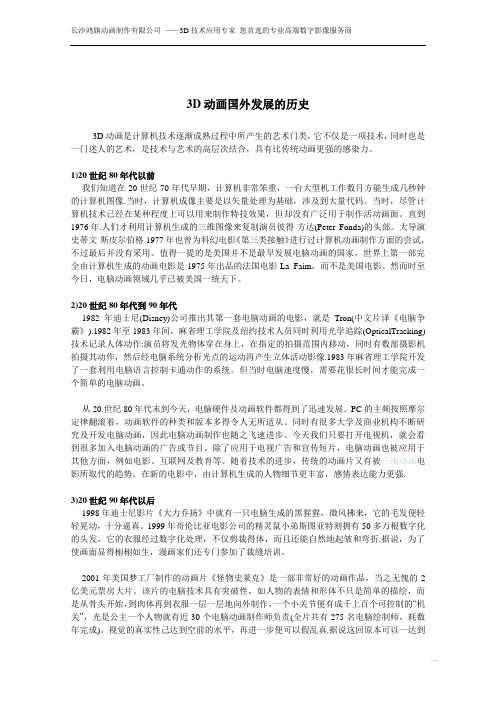
3D动画国外发展的历史3D动画是计算机技术逐渐成熟过程中所产生的艺术门类,它不仅是一项技术,同时也是一门迷人的艺术,是技术与艺术的高层次结合,具有比传统动画更强的感染力。
1)20世纪80年代以前我们知道在20世纪70年代早期,计算机非常笨重,一台大型机工作数月方能生成几秒钟的计算机图像.当时,计算机成像主要是以矢量处理为基础,涉及到大量代码。
当时,尽管计算机技术已经在某种程度上可以用来制作特技效果,但却没有广泛用于制作活动画面。
直到1976年.人们才利用计算机生成的三维图像来复制演员彼得·方达(Peter Fonda)的头部。
大导演史蒂文·斯皮尔伯格1977年也曾为科幻电影《第三类接触》进行过计算机动画制作方面的尝试,不过最后并没有采用。
值得一提的是美国并不是最早发展电脑动画的国家,世界上第一部完全由计算机生成的动画电影是1975年出品的法国电影La Faim,而不是美国电影。
然而时至今日,电脑动画领域几乎已被美国一统天下。
2)20世纪80年代到90年代1982年迪士尼(Disney)公司推出其第一套电脑动画的电影,就是Tron(中文片译《电脑争霸》).1982年至1983年间,麻省理工学院及纽约技术人员同时利用光学追踪(OpticalTracking)技术记录人体动作:演员将发光物体穿在身上,在指定的拍摄范围内移动,同时有数部摄影机拍摄其动作,然后经电脑系统分析光点的运动再产生立体活动影像.1983年麻省理工学院开发了一套利用电脑语言控制卡通动作的系统。
但当时电脑速度慢,需要花很长时间才能完成一个简单的电脑动画。
从20世纪80年代末到今天,电脑硬件及动画软件都得到了迅速发展。
PC的主频按照摩尔定律翻滚着,动画软件的种类和版本多得令人无所适从。
同时有很多大学及商业机构不断研究及开发电脑动画,因此电脑动画制作也随之飞速进步。
今天我们只要打开电视机,就会看到很多加入电脑动画的广告或节目。
游戏特效设计师招聘笔试题及解答(某大型集团公司)

招聘游戏特效设计师笔试题及解答(某大型集团公司)(答案在后面)一、单项选择题(本大题有10小题,每小题2分,共20分)1、以下哪个软件不是目前主流的游戏特效设计工具?A、Adobe After EffectsB、Unreal EngineC、MayaD、Photoshop2、在游戏特效设计中,以下哪个概念与“粒子系统”最相似?A、骨骼动画B、光照效果C、材质纹理D、粒子动画3、在Unity中,如果你想创建一个基于物理的特效,比如火焰或者烟雾,你可能会使用以下哪种组件?A. Particle SystemB. AnimatorC. RigidbodyD. Collider4、当设计游戏中的魔法特效时,为了使特效看起来更加生动和真实,通常会结合使用哪两种技术?A. 顶点动画与纹理贴图B. 粒子系统与着色器C. 骨骼动画与刚体动力学D. 光照探针与环境遮挡5、某游戏特效设计师在制作火焰特效时,需要使火焰呈现出自然、流畅的动态效果。
以下哪种技术或工具最适用于实现这一效果?A. 3D建模软件B. 纹理编辑器C. 动画软件D. 游戏引擎6、在游戏特效设计中,以下哪项不是影响特效表现力的关键因素?A. 动态范围B. 精细程度C. 时间感D. 色彩搭配7、下列哪一项不是粒子系统的主要用途?A. 创建火焰效果B. 创建水流效果C. 创建地形D. 创建烟雾效果8、在Unity引擎中,为了实现更真实的雨滴效果,以下哪个组件最有可能被使用?A. RigidbodyB. ColliderC. Particle SystemD. Animator9、在游戏特效设计中,以下哪项不是常用的三维特效类型?()A、粒子特效B、光线追踪特效C、2D动画特效D、流体动力学特效 10、以下关于游戏特效设计师的技能要求,哪项不属于基本技能?()A、熟悉3D建模软件B、了解游戏引擎原理C、具备良好的审美能力D、精通编程语言二、多项选择题(本大题有10小题,每小题4分,共40分)1、在游戏开发中,使用粒子系统来实现特效时,可以调整哪些参数来优化粒子的表现效果?A. 粒子的数量B. 粒子的形状与纹理C. 粒子的发射速度与方向D. 粒子的生命周期E. 粒子的颜色变化F. 粒子的重力加速度G. 粒子之间的相互作用H. 粒子的碰撞检测2、为了实现高质量的游戏特效,除了粒子系统外,还可以运用哪些技术手段?A. 模型动画B. 纹理贴图C. 光照计算D. 声音效果E. 深度缓冲F. 后处理效果G. 硬件加速H. 动态模糊3、以下哪些技术是游戏特效设计师在创作游戏特效时常用的?()A. 3D建模B. 2D动画C. Unity Shader编程D. Python脚本E. Maya动画4、在游戏特效设计中,以下哪些原则是确保效果流畅性和真实性的关键?()A. 时间控制B. 动力学模拟C. 材质和纹理的优化D. 负载平衡E. 用户交互设计5、在使用Unity进行游戏特效设计时,以下哪些方法可以用来优化粒子系统的性能?(多选)A. 减少同时活跃的粒子数量B. 降低粒子的生命周期C. 使用GPU粒子系统代替CPU粒子系统D. 增加粒子系统的发射速率6、关于游戏特效中的色彩理论应用,下列说法正确的是?(多选)A. 冷色调往往给人以平静、远离的感觉。
Twinmotion使用指南

第四章 镜头剪辑 .....................................................................................................................................................15
模型负载测试twinmotion作为实时渲染软件在模型载入时将其数据完全读取以最真实的场景表达模型状态在渲染硬件性能有限的情况下当项目为由多个建筑子项构成的建筑群时设计者应将根据使用设备进行运行负载测试调整模型精度与数量以确保在模型整体读取后的工作不会因大量的等待程序响应时间而荒废同时也保证动画可以在合理的时间长度内渲染输出
第一章 软硬件配置及工作流概述 ........................................................................................................................... 2
一. 硬件配置.............................................................................................................................................................. 2 二. 软件环境配置...................................................................................................................................................... 3 三. 整体工作流概述.................................................................................................................................................. 6
OSG基础教程官方的四程序

OSG基础教程官方的四程序OSG(OpenSceneGraph)是一个开源的3D图形渲染库,被广泛应用于虚拟现实、游戏开发、模拟仿真等领域。
本文将介绍OSG的四个基础程序。
1. osgviewerosgviewer是OSG的基本浏览器程序,它可以加载、渲染和交互显示3D模型。
它支持多种文件格式,如3DS、OBJ、STL等。
使用osgviewer,你可以通过命令行参数加载和显示3D模型,或使用交互式操作来浏览模型。
2. osganimateosganimate是一个用于播放和控制动画的程序。
它可以对加载的3D模型进行动画效果的展示,例如旋转、缩放、平移等。
osganimate还提供了控制动画播放速度、循环播放等功能,使你可以更好地展示模型的动态效果。
3. osgwidgetosgwidget是一个在Qt应用程序中嵌入OSG场景的控件。
借助osgwidget,你可以将OSG场景嵌入到Qt的窗口中,实现更复杂的交互和界面设计。
osgwidget还提供了与OSG场景的交互能力,允许用户在嵌入的OSG场景中进行操作。
4. osgviewerQTosgviewerQT是一个结合了osgviewer和osgwidget的程序。
它集成了osgviewer的3D场景渲染能力和osgwidget的界面嵌入特性。
osgviewerQT可以在Qt应用程序中直接加载和显示3D模型,同时提供了类似于osgviewer的命令行参数和交互功能,让你能够更方便地在Qt应用程序中展示和操作3D模型。
这四个程序提供了基本的功能和示例,帮助你快速了解和上手OSG。
通过osgviewer,你可以直接查看和操作3D模型;通过osganimate,你可以展示模型的动态效果;通过osgwidget和osgviewerQT,你可以将OSG场景嵌入到Qt应用程序中,实现更复杂的界面和交互。
除了这些官方的程序,OSG还有更多的功能和扩展库可以使用,例如osgText(用于显示文本)、osgGA(用于处理用户交互)、osgUtil(提供各种实用工具)、osgDB(用于读取和写入3D模型文件)、osgFX(提供各种特效)等。
3D动画项目策划案例3篇
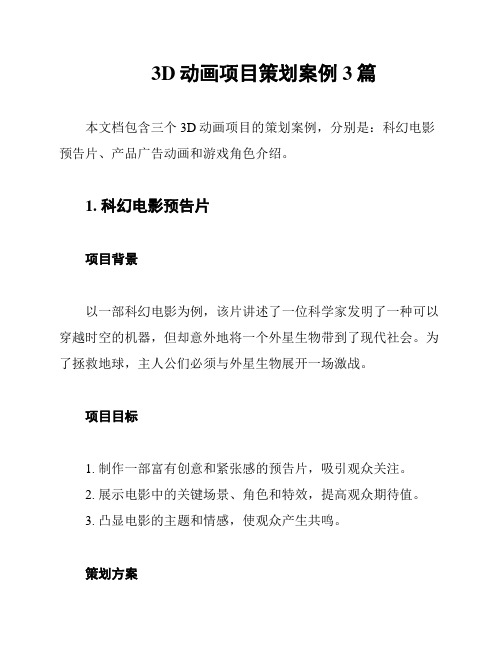
3D动画项目策划案例3篇本文档包含三个3D动画项目的策划案例,分别是:科幻电影预告片、产品广告动画和游戏角色介绍。
1. 科幻电影预告片项目背景以一部科幻电影为例,该片讲述了一位科学家发明了一种可以穿越时空的机器,但却意外地将一个外星生物带到了现代社会。
为了拯救地球,主人公们必须与外星生物展开一场激战。
项目目标1. 制作一部富有创意和紧张感的预告片,吸引观众关注。
2. 展示电影中的关键场景、角色和特效,提高观众期待值。
3. 凸显电影的主题和情感,使观众产生共鸣。
策划方案1. 故事线:选取电影中的关键情节,如科学家发明时空机器、外星生物降临、主人公备战等,通过紧张的剪辑手法呈现故事脉络。
2. 角色展示:着重展示主人公、反派角色和外星生物的形象特点,以三维建模和动画效果呈现。
3. 场景设计:结合电影背景,设计具有科幻感的未来城市、实验室和时空隧道等场景。
4. 特效制作:利用三维特效技术,制作出震撼的爆炸、激光战斗等场面,增强视觉冲击力。
5. 音乐和声效:选用激昂、紧张的音乐和声效,烘托氛围,提高观众的情绪。
6. 剪辑和节奏:采用快速剪辑、慢动作等手法,塑造紧张、刺激的观影体验。
2. 产品广告动画项目背景以一款智能家居产品为例,该产品具有语音控制、智能联动、安防监控等功能。
项目目标1. 制作一部富有创意的广告动画,展示产品特点和优势。
2. 提高观众对产品的兴趣和购买欲望。
策划方案1. 产品展示:通过三维建模和动画效果,直观地展示产品外观、结构和功能。
2. 场景设计:设计一个温馨的家庭环境,展示产品在实际生活中的应用场景。
3. 角色设计:创作一组卡通风格的角色,代表不同家庭成员,展现产品给人们带来的便捷和愉悦。
4. 故事线:围绕家庭成员的日常作息,展示产品如何智能地操控家居设备,提高生活品质。
5. 特效制作:利用三维特效技术,制作出炫酷的智能操作和联动效果。
6. 音乐和声效:选用轻松、愉快的音乐和声效,营造温馨的氛围。
《Animate CC动画制作案例教程》模块4 高级动画

3. 3D旋转工具
4.3 制作3D动画
(1)旋转单个对象 ① 在工具面板中选择“3D旋转工具”。 ② 将该工具设置为局部或全局模式。通过选中工具面板“选项”
中的“全局转换”按钮,确保该工具处于所需模式。 ③ 在舞台中选择一个对象,3D旋转控件将显示在所选对象上。 ④ 将指针分别放在四个旋转轴控件上时,指针会发生变化。左右
图层类型为“一般”。
6.运动引导动画制作技巧
4.1运动引导动画
(1)调整到路径 创建补间动画时,如果选择了补间属性面板上的“调整到路径”,补间元素的 基线就会调整到运动路径,运动对象会根据路径形状调整角度,动画效果更加 逼真。在下图中,右图选择了“调整到路径”属性,左图则没有。
4.2 遮罩动画
遮罩动画
4.1运动引导动画
3.创建运动引导动画的方法
4.1运动引导动画
(1)创建有传统补间动画的动画序列。 (2)用鼠示右键单击包含传统补间的图层名称,在弹出的菜单中选择“添加传 统运动引导层”命令,Animate 会在传统补间图层上方添加一个运动引导层,该 图层名称的左侧有一个运动引导层图标 。包含传统补间动画的图层成为被引导层,
模块4 高级动画
4.1 运动引导动画 4.2 遮罩动画 4.3 制作3D动画 4.4 骨骼动画
1.普通引导层
4.1运动引导动画
使用引导层,可以帮助用户对齐对象。引导层不会导出,因此不会显示 在发布的SWF文件中。
用户可以使用钢笔工具、铅笔工具、画笔工具、线条工具、椭圆形工具、 矩形工具等在引导层绘制所需的引导路径,
拖动X轴控件可绕X轴旋转;上下拖动 Y轴控件可绕Y轴旋转;拖动Z轴 控件进行圆周运动可绕Z轴旋转。拖动自由旋转轴控件(外侧橙色圈) 同时绕X和Y轴旋转的效果如下图所示。
VW_01058
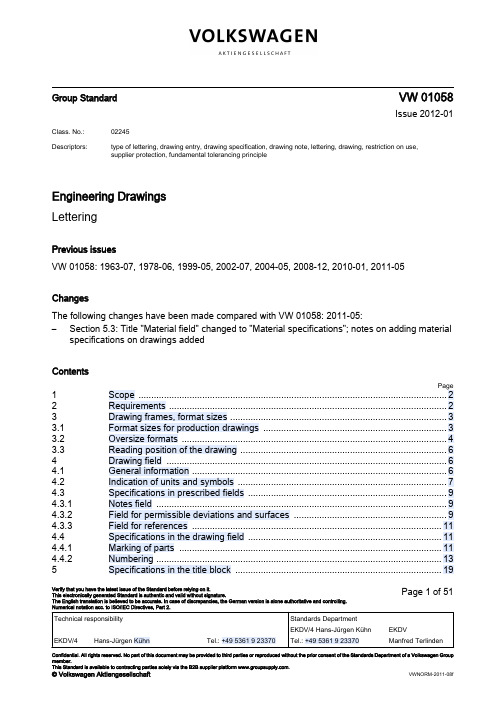
member.
This Standard is available to contracting parties solely via the B2B supplier platform .
© Volkswagen AktiengesellschaftΒιβλιοθήκη VWNORM-2011-08f
Engineering Drawings Lettering
Previous issues VW 01058: 1963-07, 1978-06, 1999-05, 2002-07, 2004-05, 2008-12, 2010-01, 2011-05
Changes
The following changes have been made compared with VW 01058: 2011-05: – Section 5.3: Title "Material field" changed to "Material specifications"; notes on adding material
Group Standard
VW 01058
Issue 2012-01
Class. No.: Descriptors:
02245
type of lettering, drawing entry, drawing specification, drawing note, lettering, drawing, restriction on use, supplier protection, fundamental tolerancing principle
Verify that you have the latest issue of the Standard before relying on it. This electronically generated Standard is authentic and valid without signature. The English translation is believed to be accurate. In case of discrepancies, the German version is alone authoritative and controlling. Numerical notation acc. to ISO/IEC Directives, Part 2.
精彩的 好看的 3D 动画 电影 推荐 68个
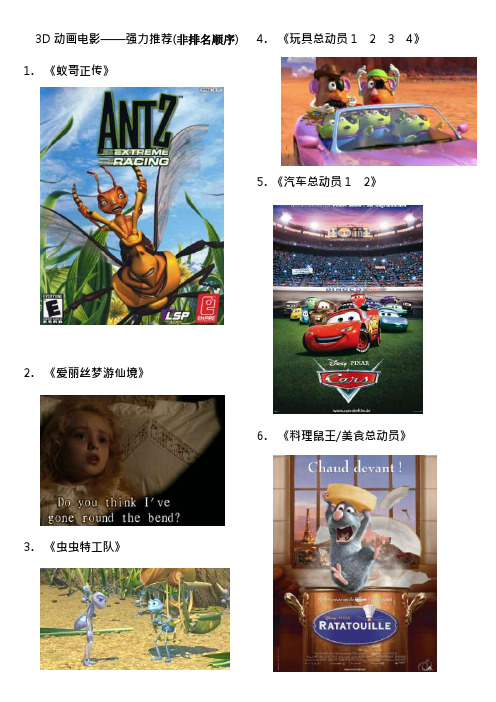
3D动画电影——强力推荐(非排名顺序) 1.《蚁哥正传》2.《爱丽丝梦游仙境》3.《虫虫特工队》4.《玩具总动员1 2 3 4》5.《汽车总动员1 2》6.《料理鼠王/美食总动员》7.《机器人9号》8.《机器总动员/瓦力》9.《蔬菜宝贝历险记》10.《小鸡快跑》11.《豚鼠总动员》12.《爱丽丝梦游仙境》13.《怪物电力公司》14.《闪电狗》15.《丛林有情狼》16.《驯龙记/驯龙高手》17.《长发公主》18.《蜜蜂总动员》19.《虫虫特工队》20.《猫头鹰列国》21.《加菲猫》22.《木偶奇遇记》23.《超人特工队》24.《超级大坏蛋》25.《四眼天鸡26.《倒霉熊系列》27.《里约大冒险》28.《蓝精灵》29.《亚瑟和他的迷你王国》30.《未来小子》31.《石破天惊》32.《邪恶新世界》33.《世博总动员》34.《马丽和马克思》35.《超蛙战士》36.《兔侠传奇》37.《机器人之死》38.《熊与弓》39.《蝾螈》——概念图40.《美女与野兽》无图41.《僵尸新娘》42.《鼠国流浪记》43.《怪兽屋》44.《极地特快》45.《鬼妈妈》46.《帝企鹅日记》47.《快乐大脚》48.《冲浪企鹅》49.《飞天巨桃历险记》50.《海底总动员》51.《兰戈》52.《鼠来宝》53.《小叮当》54.《功夫熊猫1 2》55.《马达加斯加1 2》56.《怪物史莱克1 2 3 4》57.《篱笆墙外1 2 》58.《冰河世纪1 2 3 4》59.《别惹蚂蚁》60.《飞屋环游记》61.《疯狂农场》62.《动物总动员》63.《霍顿与无名氏》64.《鲨鱼黑帮》65.《火星救母记》66.《浪漫小老鼠》67.《精灵鼠小弟》68.《最终幻想》。
A Practical Guide to Quantitative Finance Interview (Part)
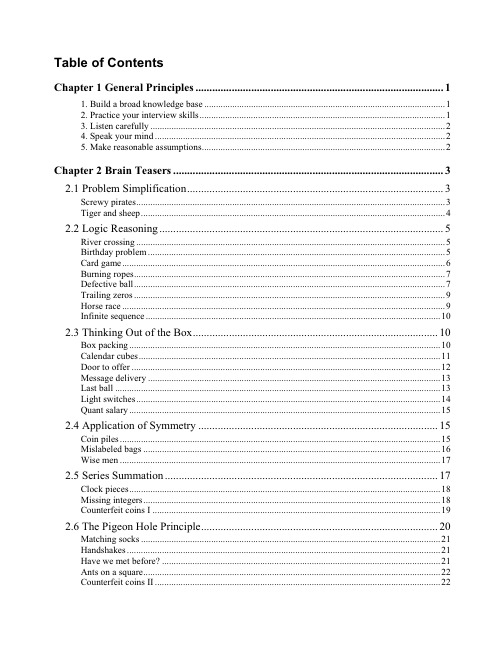
Table of ContentsChapter 1 General Principles (1)1. Build a broad knowledge base (1)2. Practice your interview skills (1)3. Listen carefully (2)4. Speak your mind (2)5. Make reasonable assumptions (2)Chapter 2 Brain Teasers (3)2.1 Problem Simplification (3)Screwy pirates (3)Tiger and sheep (4)2.2 Logic Reasoning (5)River crossing (5)Birthday problem (5)Card game (6)Burning ropes (7)Defective ball (7)Trailing zeros (9)Horse race (9)Infinite sequence (10)2.3 Thinking Out of the Box (10)Box packing (10)Calendar cubes (11)Door to offer (12)Message delivery (13)Last ball (13)Light switches (14)Quant salary (15)2.4 Application of Symmetry (15)Coin piles (15)Mislabeled bags (16)Wise men (17)2.5 Series Summation (17)Clock pieces (18)Missing integers (18)Counterfeit coins I (19)2.6 The Pigeon Hole Principle (20)Matching socks (21)Handshakes (21)Have we met before? (21)Ants on a square (22)Counterfeit coins II (22)Contentsii 2.7 Modular Arithmetic (23)Prisoner problem (24)Division by 9 (25)Chameleon colors (26)2.8 Math Induction (27)Coin split problem (27)Chocolate bar problem (28)Race track (29)2.9 Proof by Contradiction (31)Irrational number (31)Rainbow hats (31)Chapter 3 Calculus and Linear Algebra (33)3.1 Limits and Derivatives (33)Basics of derivatives (33)Maximum and minimum (34)L’Hospital’s rule (35)3.2 Integration (36)Basics of integration (36)Applications of integration (38)Expected value using integration (40)3.3 Partial Derivatives and Multiple Integrals (40)3.4 Important Calculus Methods (41)Taylor’s series (41)Newton’s method (44)Lagrange multipliers (45)3.5 Ordinary Differential Equations (46)Separable differential equations (47)First-order linear differential equations (47)Homogeneous linear equations (48)Nonhomogeneous linear equations (49)3.6 Linear Algebra (50)Vectors (50)QR decomposition (52)Determinant, eigenvalue and eigenvector (53)Positive semidefinite/definite matrix (56)LU decomposition and Cholesky decomposition (57)Chapter 4 Probability Theory (59)4.1 Basic Probability Definitions and Set Operations (59)Coin toss game (61)Card game (61)Drunk passenger (62)A Practical Guide To Quantitative Finance InterviewsN points on a circle (63)4.2 Combinatorial Analysis (64)Poker hands (65)Hopping rabbit (66)Screwy pirates 2 (67)Chess tournament (68)Application letters (69)Birthday problem (71)100th digit (71)Cubic of integer (72)4.3 Conditional Probability and Bayes’ formula (72)Boys and girls (73)All-girl world? (74)Unfair coin (74)Fair probability from an unfair coin (75)Dart game (75)Birthday line (76)Dice order (78)Monty Hall problem (78)Amoeba population (79)Candies in a jar (79)Coin toss game (80)Russian roulette series (81)Aces (82)Gambler’s ruin problem (83)Basketball scores (84)Cars on road (85)4.4 Discrete and Continuous Distributions (86)Meeting probability (88)Probability of triangle (89)Property of Poisson process (90)Moments of normal distribution (91)4.5 Expected Value, Variance & Covariance (92)Connecting noodles (93)Optimal hedge ratio (94)Dice game (94)Card game (95)Sum of random variables (95)Coupon collection (97)Joint default probability (98)4.6 Order Statistics (99)Expected value of max and min (99)Correlation of max and min (100)Random ants (102)Chapter 5 Stochastic Process and Stochastic Calculus (105)iiiContentsiv 5.1 Markov Chain (105)Gambler’s ruin problem (107)Dice question (108)Coin triplets (109)Color balls (113)5.2 Martingale and Random walk (115)Drunk man (116)Dice game (117)Ticket line (117)Coin sequence (119)5.3 Dynamic Programming (121)Dynamic programming (DP) algorithm (122)Dice game (123)World series (123)Dynamic dice game (126)Dynamic card game (127)5.4 Brownian Motion and Stochastic Calculus (129)Brownian motion (129)Stopping time/ first passage time (131)Ito’s lemma (135)Chapter 6 Finance (137)6.1. Option Pricing (137)Price direction of options (137)Put-call parity (138)American v.s. European options (139)Black-Scholes-Merton differential equation (142)Black-Scholes formula (143)6.2. The Greeks (149)Delta (149)Gamma (152)Theta (154)Vega (156)6.3. Option Portfolios and Exotic Options (158)Bull spread (159)Straddle (159)Binary options (160)Exchange options (161)6.4. Other Finance Questions (163)Portfolio optimization (163)Value at risk (164)Duration and convexity (165)Forward and futures (167)Interest rate models (168)A Practical Guide To Quantitative Finance Interviews Chapter 7 Algorithms and Numerical Methods (171)7.1. Algorithms (171)Number swap (172)Unique elements (173)Horner's algorithm (174)Moving average (174)Sorting algorithm (174)Random permutation (176)Search algorithm (177)Fibonacci numbers (179)Maximum contiguous subarray (180)7.2. The Power of Two (182)Power of 2? (182)Multiplication by 7 (182)Probability simulation (182)Poisonous wine (183)7.3 Numerical Methods (184)Monte Carlo simulation (184)Finite difference method (189)vChapter 2 Brain TeasersIn this chapter, we cover problems that only require common sense, logic, reasoning, and basic—no more than high school level—math knowledge to solve. In a sense, they are real brain teasers as opposed to mathematical problems in disguise. Although these brain teasers do not require specific math knowledge, they are no less difficult than other quantitative interview problems. Some of these problems test your analytical and general problem-solving skills; some require you to think out of the box; while others ask you to solve the problems using fundamental math techniques in a creative way. In this chapter, we review some interview problems to explain the general themes of brain teasers that you are likely to encounter in quantitative interviews.2.1 Problem SimplificationIf the original problem is so complex that you cannot come up with an immediate solution, try to identify a simplified version of the problem and start with it. Usually you can start with the simplest sub-problem and gradually increase the complexity. You do not need to have a defined plan at the beginning. Just try to solve the simplest cases and analyze your reasoning. More often than not, you will find a pattern that will guide you through the whole problem.Screwy piratesFive pirates looted a chest full of 100 gold coins. Being a bunch of democratic pirates, they agree on the following method to divide the loot:The most senior pirate will propose a distribution of the coins. All pirates, including the most senior pirate, will then vote. If at least 50% of the pirates (3 pirates in this case) accept the proposal, the gold is divided as proposed. If not, the most senior pirate will be fed to shark and the process starts over with the next most senior pirate… The process is repeated until a plan is approved. You can assume that all pirates are perfectly rational: they want to stay alive first and to get as much gold as possible second. Finally, being blood-thirsty pirates, they want to have fewer pirates on the boat if given a choice between otherwise equal outcomes.How will the gold coins be divided in the end?Solution: If you have not studied game theory or dynamic programming, this strategy problem may appear to be daunting. If the problem with 5 pirates seems complex, we can always start with a simplified version of the problem by reducing the number of pirates. Since the solution to 1-pirate case is trivial, let’s start with 2 pirates. The seniorBrain Teasers4pirate (labeled as 2) can claim all the gold since he will always get 50% of the votes from himself and pirate 1 is left with nothing.Let’s add a more senior pirate, 3. He knows that if his plan is voted down, pirate 1 will get nothing. But if he offers private 1 nothing, pirate 1 will be happy to kill him. So pirate 3 will offer private 1 one coin and keep the remaining 99 coins, in which strategy the plan will have 2 votes from pirate 1 and 3.If pirate 4 is added, he knows that if his plan is voted down, pirate 2 will get nothing. So pirate 2 will settle for one coin if pirate 4 offers one. So pirate 4 should offer pirate 2 one coin and keep the remaining 99 coins and his plan will be approved with 50% of the votes from pirate 2 and 4.Now we finally come to the 5-pirate case. He knows that if his plan is voted down, both pirate 3 and pirate 1 will get nothing. So he only needs to offer pirate 1 and pirate 3 one coin each to get their votes and keep the remaining 98 coins. If he divides the coins this way, he will have three out of the five votes: from pirates 1 and 3 as well as himself.Once we start with a simplified version and add complexity to it, the answer becomes obvious. Actually after the case 5,n a clear pattern has emerged and we do not need to stop at 5 pirates. For any 21n pirate case (n should be less than 99 though), the most senior pirate will offer pirates 1,3,, and 21n each one coin and keep the rest for himself.Tiger and sheepOne hundred tigers and one sheep are put on a magic island that only has grass. Tigers can eat grass, but they would rather eat sheep. Assume: A . Each time only one tiger can eat one sheep, and that tiger itself will become a sheep after it eats the sheep. B . All tigers are smart and perfectly rational and they want to survive. So will the sheep be eaten?Solution: 100 is a large number, so again let’s start with a simplified version of the problem . If there is only 1 tiger (1n ), surely it will eat the sheep since it does not need to worry about being eaten. How about 2 tigers? Since both tigers are perfectly rational, either tiger probably would do some thinking as to what will happen if it eats the sheep. Either tiger is probably thinking: if I eat the sheep, I will become a sheep; and then I will be eaten by the other tiger. So to guarantee the highest likelihood of survival, neither tiger will eat the sheep.If there are 3 tigers, the sheep will be eaten since each tiger will realize that once it changes to a sheep, there will be 2 tigers left and it will not be eaten. So the first tiger that thinks this through will eat the sheep. If there are 4 tigers, each tiger will understandA Practical Guide To Quantitative Finance Interviews5that if it eats the sheep, it will turn to a sheep. Since there are 3 other tigers, it will be eaten. So to guarantee the highest likelihood of survival, no tiger will eat the sheep.Following the same logic, we can naturally show that if the number of tigers is even, the sheep will not be eaten. If the number is odd, the sheep will be eaten. For the case 100,n the sheep will not be eaten.2.2 Logic ReasoningRiver crossingFour people, A ,B ,C and D need to get across a river. The only way to cross the river is by an old bridge, which holds at most 2 people at a time. Being dark, they can't cross the bridge without a torch, of which they only have one. So each pair can only walk at the speed of the slower person. They need to get all of them across to the other side as quickly as possible. A is the slowest and takes 10 minutes to cross; B takes 5 minutes; C takes 2 minutes; and D takes 1 minute.What is the minimum time to get all of them across to the other side?1Solution: The key point is to realize that the 10-minute person should go with the 5-minute person and this should not happen in the first crossing, otherwise one of them have to go back. So C and D should go across first (2 min); then send D back (1min); A and B go across (10 min); send C back (2min); C and D go across again (2 min). It takes 17 minutes in total. Alternatively, we can send C back first and then D back in the second round, which takes 17 minutes as well.Birthday problemYou and your colleagues know that your boss A ’s birthday is one of the following 10 dates:Mar 4, Mar 5, Mar 8Jun 4, Jun 7Sep 1, Sep 5Dec 1, Dec 2, Dec 8A told you only the month of his birthday, and told your colleague C only the day. After that, you first said: “I don’t know A ’s birthday; C doesn’t know it either.” After hearing 1 Hint: The key is to realize that A andB should get across the bridge together.Brain Teasers6what you said, C replied: “I didn’t know A ’s birthday, but now I know it.” You smiled and said: “Now I know it, too.” After looking at the 10 dates and hearing your comments, your administrative assistant wrote down A ’s birthday without asking any questions. So what did the assistant write?Solution: Don’t let the “he said, she said” part confuses you. Just interpret the logic behind each individual’s comments and try your best to derive useful information from these comments.Let D be the day of the month of A ’s birthday, we have {1,2,4,5,7,8}.D If the birthday is on a unique day, C will know the A ’s birthday immediately. Among possible D s, 2 and 7 are unique days. Considering that you are sure that C does not know A ’s birthday, you must infer that the day the C was told of is not 2 or 7. C onclusion: the month is not June or December. (If the month had been June, the day C was told of may have been 2; if the month had been December, the day C was told of may have been 7.) Now C knows that the month must be either March or September. He immediately figures out A ’s birthday, which means the day must be unique in the March and September list. It means A ’s birthday cannot be Mar 5, or Sep 5. C onclusion: the birthday must be Mar 4, Mar 8 or Sep 1.Among these three possibilities left, Mar 4 and Mar 8 have the same month. So if the month you have is March, you still cannot figure out A ’s birthday. Since you can figure out A ’s birthday, A ’s birthday must be Sep 1. Hence, the assistant must have written Sep 1.Card gameA casino offers a card game using a normal deck of 52 cards. The rule is that you turn over two cards each time. For each pair, if both are black, they go to the dealer’s pile; if both are red, they go to your pile; if one black and one red, they are discarded. The process is repeated until you two go through all 52 cards. If you have more cards in your pile, you win $100; otherwise (including ties) you get nothing. The casino allows you to negotiate the price you want to pay for the game. How much would you be willing to pay to play this game?2Solution: This surely is an insidious casino. No matter how the cards are arranged, you and the dealer will always have the same number of cards in your piles. Why? Because each pair of discarded cards have one black card and one red card, so equal number of2Hint: Try to approach the problem using symmetry. Each discarded pair has one black and one red card. What does that tell you as to the number of black and red cards in the rest two piles?A Practical Guide To Quantitative Finance Interviews7red and black cards are discarded. As a result, the number of red cards left for you and the number of black cards left for the dealer are always the same. The dealer always wins! So we should not pay anything to play the game.Burning ropesYou have two ropes, each of which takes 1 hour to burn. But either rope has different densities at different points, so there's no guarantee of consistency in the time it takes different sections within the rope to burn. How do you use these two ropes to measure 45 minutes?Solution: This is a classic brain teaser question. For a rope that takes x minutes to burn, if you light both ends of the rope simultaneously, it takes /2x minutes to burn. So we should light both ends of the first rope and light one end of the second rope. 30 minutes later, the first rope will get completely burned, while that second rope now becomes a 30-min rope. At that moment, we can light the second rope at the other end (with the first end still burning), and when it is burned out, the total time is exactly 45 minutes. Defective ballYou have 12 identical balls. One of the balls is heavier OR lighter than the rest (you don't know which). Using just a balance that can only show you which side of the tray is heavier, how can you determine which ball is the defective one with 3 measurements?3Solution: This weighing problem is another classic brain teaser and is still being asked by many interviewers. The total number of balls often ranges from 8 to more than 100.Here we use 12nto show the fundamental approach. The key is to separate the original group (as well as any intermediate subgroups) into three sets instead of two. The reason is that the comparison of the first two groups always gives information about the third group.Considering that the solution is wordy to explain, I draw a tree diagram in Figure 2.1 to show the approach in detail. Label the balls 1 through 12 and separate them to three groups with 4 balls each. Weigh balls 1, 2, 3, 4 against balls 5, 6, 7, 8. Then we go on to explore two possible scenarios: two groups balance, as expressed using an “=” sign, or 1, 3Hint: First do it for 9 identical balls and use only 2 measurements, knowing that one is heavier than the rest.Brain Teasers82, 3, 4 are lighter than 5, 6, 7, 8, as expressed using an “<” sign. There is no need to explain the scenario that 1, 2, 3, 4 are heavier than 5, 6, 7, 8. (Why?4)If the two groups balance, this immediately tells us that the defective ball is in 9, 10, 11 and 12, and it is either lighter (L ) or heavier (H ) than other balls. Then we take 9, 10 and 11 from group 3 and compare balls 9, 10 with 8, 11. Here we have already figured out that 8 is a normal ball. If 9, 10 are lighter, it must mean either 9 or 10 is L or 11 is H . In which case, we just compare 9 with 10. If 9 is lighter, 9 is the defective one and it is L ; if 9 and 10 balance, then 11 must be defective and H ; If 9 is heavier, 10 is the defective one and it is L . If 9, 10 and 8, 11 balance, 12 is the defective one. If 9, 10 is heavier, than either 9 or 10 is H, or 11 is L.You can easily follow the tree in Figure 2.1 for further analysis and it is clear from the tree that all possible scenarios can be resolved in 3 measurements. In general if you have the information as to whether the defective ball is heavier or 4 Here is where the symmetry idea comes in. Nothing makes the 1, 2, 3, 4 or 5, 6, 7, 8 labels special. If 1, 2, 3, 4 are heavier than 5, 6, 7, 8, let’s just exchange the labels of these two groups. Again we have the case of 1, 2, 3, 4 being lighter than 5, 6, 7, 8.1/2L or 6H5H or 3L4L or 7/8H 12L or 12H 9/10H or 11L 9/10L or 11H 5,6,7,8+?1,2,53,6,9_1/2/3/4 L or 5/6/7/8 H1L 6H 2L 8H 4L 7H 3L 5H 2_18_79_39,108,11_9/10/11/12 L or H 9L 11H 10L 12H 11L 12L 10H 9H_912_8_9Figure 2.1 Tree diagram to identify the defective ball in 12 ballsA Practical Guide To Quantitative Finance Interviews9lighter, you can identify the defective ball among up to 3n balls using no more than n measurements since each weighing reduces the problem size by 2/3. If you have no information as to whether the defective ball is heavier or lighter, you can identify the defective ball among up to (33)/2n balls using no more than n measurements. Trailing zerosHow many trailing zeros are there in 100! (factorial of 100)?Solution: This is an easy problem. We know that each pair of 2 and 5 will give a trailing zero. If we perform prime number decomposition on all the numbers in 100!, it is obvious that the frequency of 2 will far outnumber of the frequency of 5. So the frequency of 5 determines the number of trailing zeros. Among numbers 1,2,,99, and 100, 20 numbers are divisible by 5 (5,10,,100 ). Among these 20 numbers, 4 are divisible by 52 (25,50,75,100). So the total frequency of 5 is 24 and there are 24 trailing zeros.Horse raceThere are 25 horses, each of which runs at a constant speed that is different from the other horses’. Since the track only has 5 lanes, each race can have at most 5 horses. If you need to find the 3 fastest horses, what is the minimum number of races needed to identify them?Solution: This problem tests your basic analytical skills. To find the 3 fastest horses, surely all horses need to be tested. So a natural first step is to divide the horses to 5 groups (with horses 1-5, 6-10, 11-15, 16-20, 21-25 in each group). After 5 races, we will have the order within each group, let’s assume the order follows the order of numbers (e.g., 6 is the fastest and 10 is the slowest in the 6-10 group)5. That means 1, 6, 11, 16 and 21 are the fastest within each group.Surely the last two horses within each group are eliminated. What else can we infer? We know that within each group, if the fastest horse ranks 5th or 4th among 25 horses, then all horses in that group cannot be in top 3; if it ranks the 3rd, no other horse in that group can be in the top 3; if it ranks the 2nd, then one other horse in that group may be in top 3; if it ranks the first, then two other horses in that group may be in top 3. 5 Such an assumption does not affect the generality of the solution. If the order is not as described, just change the labels of the horses.Chapter 4 Probability TheoryC hances are that you will face at least a couple of probability problems in most quantitative interviews. Probability theory is the foundation of every aspect of quantitative finance. As a result, it has become a popular topic in quantitative interviews. Although good intuition and logic can help you solve many of the probability problems, having a thorough understanding of basic probability theory will provide you with clear and concise solutions to most of the problems you are likely to encounter. Furthermore, probability theory is extremely valuable in explaining some of the seemingly-counterintuitive results. Armed with a little knowledge, you will find that many of the interview problems are no more than disguised textbook problems.So we dedicate this chapter to reviewing basic probability theory that is not only broadly tested in interviews but also likely to be helpful for your future career. 1 The knowledge is applied to real interview problems to demonstrate the power of probability theory. Nevertheless, the necessity of knowledge in no way downplays the role of intuition and logic. Quite the contrary, common sense and sound judgment are always crucial for analyzing and solving either interview or real-life problems. As you will see in the following sections, all the techniques we discussed in Chapter 2 still play a vital role in solving many of the probability problems.Let’s have some fun playing the odds.4.1 Basic Probability Definitions and Set OperationsFirst let’s begin with some basic definitions and notations used in probability. These definitions and notations may seem dry without examples—which we will present momentarily—yet they are crucial to our understanding of probability theory. In addition, it will lay a solid ground for us to systematically approach probability problems.Outcome (Ȧ):the outcome of an experiment or trial.Sample space/Probability space ( ):the set of all possible outcomes of an experiment.1 As I have emphasized in Chapter 3, this book does not teach probability or any other math topics due to the space limit—it is not my goal to do so, either. The book gives a summary of the frequently-tested knowledge and shows how it can be applied to a wide range of real interview problems. The knowledge used in this chapter is covered by most introductory probability books. It is always helpful to pick up one or two classic probability books in case you want to refresh your memory on some of the topics. My personal favorites are First Course in Probability by Sheldon Ross and Introduction to Probability by Dimitri P. Bertsekas and John N. Tsitsiklis.Probability Theory60()P Z : Probability of an outcome (()0,,()1P P Z Z Z Z :t : ¦).Event:A set of outcomes and a subset of the sample space.()P A : Probability of an event A , ()()AP A P Z Z ¦.A B : Union A B is the set of outcomes in event A or in event B (or both).A B or AB : Intersection A B (or AB ) is the set of outcomes in both A and B .c A : The complement of A , which is the event “not A ”.Mutually Exclusive :A B ) where ) is an empty set.For any mutually exclusive events 12,,N E E E ,11().N N i i i i P E P E §· ¨¸©¹¦ Random variable: A function that maps each outcome (Ȧ) in the sample space ( ) into the set of real numbers.Let’s use the rolling of a six-sided dice to explain these definitions and notations. A roll of a dice has 6 possible outcomes (mapped to a random variable): 1, 2, 3, 4, 5, or 6. Sothe sample space :is {1,2,3,4,5,6} and the probability of each outcome is 1/6 (assuming a fair dice). We can define an event A representing the event that the outcomeis an odd number {1,3,5},Athen the complement of A is {2,4,6}.c A Clearly ()P A (1)(3)(5)1/2.P P P Let B be the event that the outcome is larger than 3: {4,5,6}.B Then the union is {1,3,4,5,6}A B and the intersection is {5}.A B One popular random variable called indicator variable (a binary dummy variable) for event A is defined as the following:1,{1,3,5}.0,{1,3,5}A if x I if x ® ¯ Basically 1A I when A occurs and 0A I if c A occurs. The expected value of A I is []()A E I P A .Now, time for some examples.A Practical Guide To Quantitative Finance Interviews61Coin toss gameTwo gamblers are playing a coin toss game. Gambler A has (1)n fair coins; B has n fair coins. What is the probability that A will have more heads than B if both flip all their coins?2Solution: We have yet to cover all the powerful tools probability theory offers. What do we have now? Outcomes, events, event probabilities, and surely our reasoning capabilities! The one extra coin makes A different from B . If we remove a coin from A ,A and B will become symmetric. Not surprisingly, the symmetry will give us a lot of nice properties. So let’s remove the last coin of A and compare the number of heads in A ’s first n coins with B ’s n coins. There are three possible outcomes:1E :A ’s n coins have more heads than B ’s n coins;2E :A ’s n coins have equal number of heads as B ’s n coins;3E :A ’s n coins have fewer heads than B ’s n coins.By symmetry, the probability that A has more heads is equal to the probability that B has more heads. So we have 13()().P E P E Let’s denote 13()()P E P E x and 2().P E y Since ()1,P Z Z :¦ we have 2 1.x y For event 1,E A will always have more headsthan B no matter what A ’s (1)n th coin’s side is; for event 3E ,A will have no moreheads than B no matter what A ’s (1)n th coin’s side is. For event 2E ,A ’s (1)n thcoin does make a difference. If it’s a head, which happens with probability 0.5, it will make A have more heads than B . So the (1)n th coin increases the probability that A has more heads than B by 0.5y and the total probability that A has more heads is 0.50.5(12)0.5x y x x when A has (1)n coins.Card gameA casino offers a simple card game. There are 52 cards in a deck with 4 cards for each value jack queen king ace 2,3,4,5,6,7,8,9,10,,,,J Q K A . Each time the cards are thoroughly shuffled (so each card has equal probability of being selected). You pick up a card from the deck and the dealer picks another one without replacement. If you have a larger number, you win; if the numbers are equal or yours is smaller, the house wins—as in all other casinos, the house always has better odds of winning. What is your probability of winning? 2 Hint: What are the possible results (events) if we compare the number of heads in A ’s first n coins withB ’s n coins? By making the number of coins equal, we can take advantage of symmetry. For each event, what will happen if A ’s last coin is a head? Or a tail?。
经典电影截至2013年全球票房前100名

1.阿凡达Avatar (2009) $27.815亿2. 泰坦尼克号Titanic (1997) $18.353亿3↑复仇者联盟The Avengers (2012) $14.444亿4.哈利·波特7:哈利·波特与死亡圣器(下) Harry Potter and the Deathly Hallows: Part 2 (2011) $13.277亿5.变形金刚3 Transformers:The Dark Of The Moon (2011) $11.237亿6. 指环王3:国王归来The Lord of the Rings : The Return of the King (2003) $11.199亿7. 加勒比海盗2:聚魂棺/亡灵宝藏Pirates of the Caribbean : Dead Man's Chest (2006) $10.659亿/第79届奥斯卡最佳视觉效果/导演:Gore Verbinski/演员:Johnny Depp,Orlando Bloom,Keira Knightley8. 玩具总动员3 Toy Story 3 (2010) 10.630亿/第83届奥斯卡最佳动画长片奖9. 加勒比海盗4:惊涛骇浪Pirates of the Caribbean: On Stranger Tides (2011) $10.420亿10. 爱丽丝梦游仙境Alice in Wonderland (2010) $10.233亿/3D--------------------------------------10------------------------------------------------11. 蝙蝠侠前传2:黑暗骑士The dark knight (2008) $10.019亿12. 哈利·波特1:哈利·波特与魔法石Harry Potter and the Sorcerer's Stone (2001) $9.687亿13. 加勒比海盗3:世界尽头Pirates of the Caribbean : At World's End (2007) $9.584亿14.哈利·波特7:哈利·波特与死亡圣器(上) Harry Potter and the Deathly Hallows: Part 1 (2010) $9.461亿15. 哈利·波特5:哈利·波特与凤凰社Harry Potter and the Order of the Phoenix (2007) $9.370亿16.哈利·波特6:哈利·波特与混血王子Harry Potter and the Half-Blood Prince (2009) $9.340亿17. 星战前传1:魅影危机Star Wars Episode I:The Phantom Menace (1999) $9.224亿18. 指环王2:双塔奇兵The Lord of the Rings: The Two Towers (2002) $9.216亿/第75届奥斯卡最佳视觉效果19. 侏罗纪公园1 Jurassic Park (1993) $9.197亿/第66届奥斯卡最佳视觉效果20. 哈利·波特4:哈利·波特与火焰杯Harry Potter and the Goblet of Fire (2005) $8.922亿---------------------------------------20-------------------------------------------------21.冰河世纪3:恐龙的黎明Ice Age: Dawn of the Dinosaurs (2009) $8.878亿/3D动画片22. 蜘蛛侠3 Spider-Man 3 (2007) $8.854亿23. 怪物史莱克2 Shrek 2 (2004) $8.809亿/动画片24. 哈利·波特2:哈利·波特与密室Harry Potter and the Chamber of Secrets (2002) $8.663亿25. 海底总动员/寻找尼莫Finding Nemo (2003) $8.650亿/第76届奥斯卡最佳动画长片奖/动画片26. 指环王1:护戒使者The Lord of the Rings: The Fellowship of the Ring (2001) $8.607亿/第74届奥斯卡最佳视觉效果27. 星战前传3:西斯的复仇Star Wars Episode III:Revenge of the Sith (2005) $8.485亿28. 变形金刚2:卷土重来Transformers: Revenge of the Fallen (2009) $8.353亿29. 盗梦空间Inception (2010) $8.171亿/第83届奥斯卡最佳视觉效果30. 独立日Independence Day (1996) $8.112亿/第69届奥斯卡最佳视觉效果31. 蜘蛛侠Spider-Man (2002) $8.067亿32. 星球大战1 Star Wars (1977) $7.979亿/第50届奥斯卡最佳视觉效果33. 史莱克3Shrek the Third (2007) $7.911亿/动画片34. 哈利·波特3:哈利·波特与阿兹卡班的囚徒Harry Potter and the Prisoner of Azkaban (2004) $7.895亿35. 蜘蛛侠2 Spider-Man 2 (2004) $7.836亿/第77届奥斯卡最佳视觉效果36. 狮子王The Lion King (1994) $7.834亿/动画片37. 夺宝奇兵4:水晶头骨王国Indiana Jones and the Kingdom of the Crystal Skull (2008) $7.830亿38. 2012 (2009) $7.668亿39. 达芬奇密码The Da Vinci Code (2006) $7.572亿40. E.T.外星人E.T. the Extra-Terrestrial (1982) $7.567亿/第55届奥斯卡最佳视觉效果41. 史莱克4 Shrek Forever After (2010) $7.503亿42. 纳尼亚传奇1:狮子、女巫和魔衣橱The Chronicles of Narnia: The Lion , the Witch and the Wardrobe (2005) $7.388亿43. 黑客帝国2:重装上阵The Matrix Reloaded (2003) $7.356亿44.飞屋环游记Up (2009) $7.271亿/第82届奥斯卡最佳动画长片奖、最佳配乐/动画片45. 暮光之城2:新月The Twilight Saga: New Moon (2009) $7.098亿46. 变形金刚1 Transformers (2007) $7.086亿47. 暮光之城3:月食The Twilight Saga: Eclipse(2010) $6.945亿48.碟中谍4:幽灵协议Mission: Impossible - Ghost Protocol (2011) $6.922亿49. 阿甘正传Forrest Gump (1994) $6.794亿/第67届奥斯卡最佳影片、最佳视觉效果50.功夫熊猫2 Kung Fu Panda 2 (2011) $6.630亿----------------------------------------50------------------------------------------------51.暮光之城4:破晓(上)The Twilight Saga: Breaking Dawn - Part 1 (2011) $6.624亿52.灵异第六感The Sixth Sense (1999) $6.615亿53.加勒比海盗1:黑珍珠号的诅咒Pirates of the Caribbean: The Curse of the Black Pearl (2003) $6.532亿54. 冰河世纪2:消融Ice Age: The Meltdown (2006) $6.523亿/动画片55. 星战前传2:克隆人的进攻Star Wars Episode II:Attack of the Clones (2002) $6.482亿56. 饥饿游戏The Hunger Games (2012) $6.408亿57. 功夫熊猫Kung Fu Panda (2008) $6.334亿/动画片58. 超人总动员The Incredibles (2004) $6.314亿/第77届奥斯卡最佳动画长片奖/动画片59.速度与激情5 Fast Five (2011) $6.243亿60. 钢铁侠2 Iron Man 2 (2010) $6.236亿61. 全民超人Hancock (2008) $6.235亿62. 料理鼠王Ratatouille(2007)$6.159亿/动画片/第80届奥斯卡最佳动画长片奖/动画片63. 侏罗纪公园2:失落的世界The Lost World: Jurassic Park (1997) $6.143亿64. 耶稣受难记The Passion of the Christ (2004) $6.044亿65. 妈妈咪呀Mamma Mia! (2008) $6.012亿66.黑衣人3 Men in Black III (2012) $5.995亿67. 马达加斯加2:逃往非洲Madagascar: Escape 2 Africa(2008) $5.941亿/动画片68. 世界之战War of the Worlds (2005) $5.914亿69. 007系列21:皇家赌场Casino Royale (2006) $5.876亿70. 黑衣人1 Men in Black (1997) $5.872亿71. 我是传奇/末世传奇I Am Legend (2007) $5.840亿72.魔发奇缘Tangled (2010) $5.766亿/动画片73. 星球大战3:绝地归来Star Wars Episode VI - Return of the Jedi (1983) $5.727亿/第56届奥斯卡特别贡献奖(最佳视觉效果)74. 钢铁侠Iron Man (2008) $5.718亿75. 博物馆奇妙夜Night at the Museum (2006) $5.710亿76. 007系列22:大破量子危机Quantum of Solace (2008) $5.700亿77. 宿醉2 The Hangover Part II (2011) $5.649亿78. 蓝精灵The Smurfs (2011) $5.590亿/动画片79. 世界末日/天地大冲撞Armageddon (1998) $5.546亿80. 汽车总动员2 Cars 2 (2011) $5.495亿/动画片81. 金刚King Kong (2005) $5.471亿/第78届奥斯卡最佳视觉效果82. 碟中碟2 Mission : Impossible II (2000) $5.453亿83.穿靴子的猫Puss in Boots (2011) $5.439亿/3D/动画片84.卑鄙的我Despicable Me (2010) $5.435亿/动画片85.大侦探福尔摩斯2 Sherlock Holmes: A Game of Shadows (2011) $5.346亿86. 小鬼当家1 Home Alone (1990) $5.338亿87. 星球大战2:帝国反击战Star Wars Episode V - The Empire Strikes Back (1980) $5.338亿/第53届奥斯卡特别贡献奖(最佳视觉效果)88. 机器人总动员W ALL·E (2008)$5.325亿/第81届奥斯卡最佳动画长片奖/动画片89. 怪物公司Monsters,Inc. (2001) $5.289亿/动画片90. 后天The Day After Tomorrow (2004) $5.279亿91. 辛普森一家The Simpsons Movie (2007) $5.255亿/动画片92.大侦探福尔摩斯1 Sherlock Holmes (2009) $5.184亿93. 人鬼情未了Ghost (1990) $5.176亿94. 终结者2:审判日Terminator 2 : Judgment Day (1991) $5.168亿/第64届奥斯卡最佳视觉效果95. 阿拉丁Aladdin (1992) $5.019亿/动画片96. 驯龙记How to Train Your Dragon (2010) $4.949亿97. 夺宝奇兵3:圣战骑兵/最后的十字军Indiana Jones and the Last Crusade (1989) $4.948亿98. 龙卷风Twister (1996) $4.947亿99. 诸神之战Clash of the Titans (2010) $4.916亿100. 里约大冒险Rio (2011) $4.861亿/动画片。
AD8313
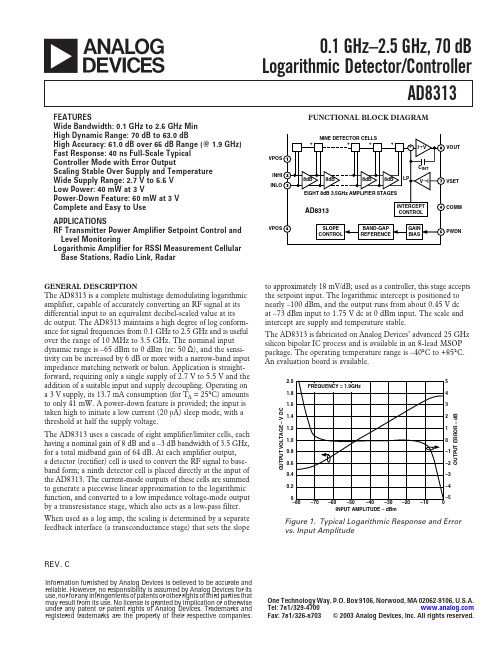
Conditions
Min2 Typ
Max2
fRF < 100 MHz3
0.1
2.5
VPOS – 0.75
10
900ʈ1.1
Sinusoidal, input termination configuration shown in Figure 11.
Nominal Conditions
53.5 65
EIGHT 8dB 3.5GHz AMPLIFIER STAGES
AD8313
INTERCEPT CONTROL
SLOPE CONTROL
BAND-GAP REFERENCE
GAIN BIAS
VOUT VSET COMM PWDN
GENERAL DESCRIPTION The AD8313 is a complete multistage demodulating logarithmic amplifier, capable of accurately converting an RF signal at its differential input to an equivalent decibel-scaled value at its dc output. The AD8313 maintains a high degree of log conformance for signal frequencies from 0.1 GHz to 2.5 GHz and is useful over the range of 10 MHz to 3.5 GHz. The nominal input dynamic range is –65 dBm to 0 dBm (re: 50 W), and the sensitivity can be increased by 6 dB or more with a narrow-band input impedance matching network or balun. Application is straightforward, requiring only a single supply of 2.7 V to 5.5 V and the addition of a suitable input and supply decoupling. Operating on a 3 V supply, its 13.7 mA consumption (for TA = 25∞C) amounts to only 41 mW. A power-down feature is provided; the input is taken high to initiate a low current (20 mA) sleep mode, with a threshold at half the supply voltage.
2013国产动画大盘点

2013年最新国产动画大盘点2013上半年快过去了,下面,让我们来盘点一下这半年来的国产动画吧!大家最喜欢哪一部呢?1.《快乐酷宝》近年来越来越多的真人动画片,快乐酷宝也是其中之一!它是一部真人科幻动画片,故事讲述的是乐乐等几个小主人公遇到了来自异世界的机器人小伙伴,帮助他们收集人类情感的正面能量,并打败邪恶的阿酷波斯的故事。
这部动画的机器人设计都十分可爱,剧情丰富,赢得了小孩子的深爱!2.《神兽金刚2之天神地兽》《神兽金刚2之天神地兽》神兽金刚第二部天神地兽,是一部中国特色的自创国产动画。
它运用中国传统神话与经典着作《山海经》中的奇山异兽,展示了中国文化和前史。
因这部动画融入了队员间的互助,正邪之争等热血元素,极受男孩子欢迎~2013年侠岚再开!第三季已播放完毕,第四季还在播放中。
本动画集热血、励志、神话题材、具备国际水准的3D技术于一身,并融入大量中国传统文化元素。
这是国产动画中面向青少年的动画,故事宏观有序,从而吸引了国内一群青少年的狂热喜好。
这是开心宝贝系列的第六部作品,延续上几部作品的幽默风格,讲述星星球的人们发现了一个新星球--古灵星,上面蕴含着各种神秘的资源。
校长和博士率领五个超人去探险,但是灰心星球司令派大小怪在探险队卧底,随时窃取探险的成果,并带回灰心星球。
超人们一边应付新环境,一边应付来自暗处的各种破坏。
5.《巴拉拉小魔仙之奇迹舞步》《巴拉拉小魔仙之奇迹舞步》为《巴拉拉小魔仙》系列第三部,与第二季同为动画作品。
这次故事讲述双子星王国遭受邪恶女王进攻,两个公主失踪,魔仙女王派出小蓝跟游乐来到地球,和美琪、美雪一起寻找公主的事情。
相比前两部动画,这部动画画风更为唯美,人物动作也流畅了很多,从开播以来就吸引了无数女孩观看~故事主要讲述了少年手指滑板的冒险!酷炫的手指滑板通过这部动画定能引领2013新潮流!7.《熊出没之过年》《熊出没之过年》是一部2013年春节的贺岁动画片,延续了熊出没动画一向的幽默风格。
c4d毕业设计
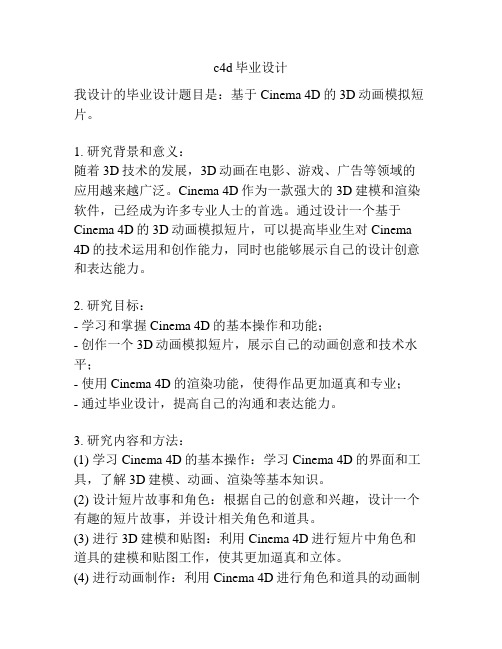
c4d毕业设计我设计的毕业设计题目是:基于Cinema 4D的3D动画模拟短片。
1. 研究背景和意义:随着3D技术的发展,3D动画在电影、游戏、广告等领域的应用越来越广泛。
Cinema 4D作为一款强大的3D建模和渲染软件,已经成为许多专业人士的首选。
通过设计一个基于Cinema 4D的3D动画模拟短片,可以提高毕业生对Cinema 4D的技术运用和创作能力,同时也能够展示自己的设计创意和表达能力。
2. 研究目标:- 学习和掌握Cinema 4D的基本操作和功能;- 创作一个3D动画模拟短片,展示自己的动画创意和技术水平;- 使用Cinema 4D的渲染功能,使得作品更加逼真和专业;- 通过毕业设计,提高自己的沟通和表达能力。
3. 研究内容和方法:(1) 学习Cinema 4D的基本操作:学习Cinema 4D的界面和工具,了解3D建模、动画、渲染等基本知识。
(2) 设计短片故事和角色:根据自己的创意和兴趣,设计一个有趣的短片故事,并设计相关角色和道具。
(3) 进行3D建模和贴图:利用Cinema 4D进行短片中角色和道具的建模和贴图工作,使其更加逼真和立体。
(4) 进行动画制作:利用Cinema 4D进行角色和道具的动画制作,使其具有生动性和表现力。
(5) 进行渲染和后期处理:利用Cinema 4D的渲染功能,对动画进行渲染,然后进行后期处理,如调色、合成等,使得作品更加专业。
(6) 完成作品展示:将完成的作品进行展示,可以选择通过视频、演示文稿等形式进行展示,向评委和观众展示自己的设计创意和技术水平。
4. 预期成果和效益:通过本次毕业设计,预计能够达到以下成果和效益:(1) 对Cinema 4D的基本操作和功能具有较好的掌握能力;(2) 设计并完成一个有趣的3D动画模拟短片;(3) 提高自己的动画创意和技术水平;(4) 展示自己的设计创意和表达能力;(5) 提高沟通和表达能力。
总之,通过Cinema 4D的应用和创作,本次毕业设计旨在提高学生对3D动画的技术运用和创作能力,同时也能够展示自己的设计创意和表达能力。
- 1、下载文档前请自行甄别文档内容的完整性,平台不提供额外的编辑、内容补充、找答案等附加服务。
- 2、"仅部分预览"的文档,不可在线预览部分如存在完整性等问题,可反馈申请退款(可完整预览的文档不适用该条件!)。
- 3、如文档侵犯您的权益,请联系客服反馈,我们会尽快为您处理(人工客服工作时间:9:00-18:30)。
物体的组合运动
• 物体可以同时进行缩放、旋转、平移。 • 但这些操作必须注意先后顺序才能得到预期的效果。
D3DXMatrixRotationZ( &matRotZ,-0.002); //绕Z轴旋转 D3DXMatrixRotationY( &matRotY,0.005); //绕Y轴旋转矩阵 matWorld=matRotZ*matRotY; //旋转矩阵相乘 • D3DXMatrixTranslation(&matMove,x,y,z ); //平移 • matWorld=matWorld*matMove; //平移矩阵相乘 pd3dDevice->SetTransform( D3DTS_WORLD,&matWorld ) //设定矩阵 • m_pD3DXMesh1->DrawSubset(0); //渲染物体
WORLD矩阵
• 用于定位物体的位置和姿态的矩阵
• 每个物体都可以在渲染前单独设置WORLD矩阵 从而使每个物体有不同的位置和姿态 • 例如:
•将矩阵1设置为WORLD矩阵 •渲染物体1 •将矩阵2设置为WORLD矩阵 •渲染物体2 •将矩阵3设置为WORLD矩阵 •渲染物体3
缩放物体
• 只要我们提供缩放矩阵,用缩放矩阵去设置 WORLD矩阵,DirectX就可以自动计算物体上各 点的新坐标,渲染时即可正确显示缩放后的状态
视线(3DMAX的摄像机(camera)) • 为了能从各个方向看对象,D3D定义了视线来 代表用户观察3D世界的角度和方向。 视矩阵(view 矩阵) 定义了观察者在3D空间的位置和朝什么方向看
pd3dDevice->SetTransform( D3DTS_VIEW, &matView );
// matView就是眼睛的观察矩阵。 view矩阵的变换类似于world矩阵,所不同的是它 改变的是人的眼睛位置 如果已经正确设置了物体的world矩阵,通过逆矩 阵可以很容易将眼睛放置于物体上:
X’= X*K_mat._11+Y*K_mat._21+Z*K_mat._31+K_mat._41 Y’= X*K_mat._12+Y*K_mat._22+Z*K_mat._32+K_mat._42 Z’= X*K_mat._13+Y*K_mat._23+Z*K_mat._33+K_mat._43
键盘控制
键盘的输入可在 MsgProc 消息处理函数中判断和处理
switch( {case WM_KEYDOWN: switch(wParam) { case 37:wry=0.01;break; case 39:wry=-0.01;break; case 38:wrx=0.01;break; case 40:wrx=-0.01;break; }break; case WM_KEYUP: switch(wParam) { case 37: case 39:wry=0;break; case 38: case 40:wrx=0;break; }break; }
pd3dDevice->SetTransform(D3DTS_PROJECTION, &matProj);
视线(3DMAX的摄像机(camera)) • 为了能从各个方向看对象,D3D定义了视矩阵 (view 矩阵)来代表用户观察的角度和方向。 在 OnD3D9FrameRender() 中加代码:
鼠标控制
case WM_MOUSEMOVE: {short x,y,*pxy; pxy=(short*)&lParam; x=*pxy; y=*(pxy+1); wry=((float)x-screen_w/2)/10/screen_w; }break; case WM_LBUTTONDOWN: break; case WM_LBUTTONUP: break;
一个向量乘以一个矩阵即得到一个新的向量
• X’= X*_11+Y*_21+Z*_31+_41 • Y’= X*_12+Y*_22+Z*_32+_42 • Z’= X*_13+Y*_23+Z*_33+_43
用矩阵控制场景
• 屏幕的景象取决于3个矩阵:
• WORLD矩阵: 控制物体的位置、大小、姿态 • VIEW矩阵: 控制眼睛的位置、朝向 • PROJECTION矩阵:控制眼睛的视角宽度、景深
3D动画
aa
向量(vector)
• 我们说一个模型就是一个对象 对象都有其位置和方向,在3D空间中由三个值定义: x,y,z。 D3D中的位置和方向都是向量,向量定义为:
typedef struct _D3DVECTOR { float x; // x坐标 float y; // y坐标 float z; // z坐标 } D3DVECTOR;
平面倾角的判断
法向量c=向量a×向量b=(X1,Y1,Z1) ×(X2,Y2,Z2) i j k X1 Y1 Z1 =(Y1Z2-Y2Z1,Z1X2-X1Z2,X1Y2-X2Y1) X2 Y2 Z2
(i、j、k分别为空间中相互垂直的三条坐标轴的单位向பைடு நூலகம்)。
D3DXVec3Cross( &v0, &v1, &v2 ); a C b
其中WORLD矩阵最为常用,任何物体的移动、旋转、缩放 都是通过改变WORLD矩阵实现,复合变换可以通过将移 动矩阵、旋转矩阵、缩放矩阵相乘的方法实现。 系统只有一个WORLD矩阵,每渲染一个物体必须先设置一 次WORLD矩阵,才能正确显示不同物体的不同姿态
PROJECTION矩阵:控制眼睛的视角宽度、景深
在 OnD3D9FrameRender() 中加代码:
{…… D3DXMATRIX matScale; //定义缩放矩阵 D3DXMatrixScaling(& matScale,2.0,1.0,3.0); //缩放 pd3dDevice->SetTransform( D3DTS_WORLD, &matScale ); //设定WORLD矩阵 m_pD3DXMesh1->DrawSubset(0); //渲染物体 …… }
矩阵(matrix)
• 对象有了方向和位置后,要对其进行移动、放缩和 旋转等处理就需要用到矩阵。矩阵在D3D中的定义如下: typedef struct _D3DMATRIX { union { struct { float _11, _12, _13, _14; float _21, _22, _23, _24; float _31, _32, _33, _34; float _41, _42, _43, _44; }; float m[4][4]; }; } D3DMATRIX; 一个向量乘以一个矩阵即得到一个新的向量 如果这个新的向量和原向量是平移关系该矩阵称为平移矩阵 如果这个新的向量和原向量是旋转关系该矩阵称为旋转矩阵
平移物体
• 只要我们提供平移矩阵,用平移矩阵去设置 WORLD矩阵,DirectX就可以自动计算物体上各 点的新坐标,渲染时即可正确显示平移后的状态
在 OnD3D9FrameRender() 中加代码:
{…… D3DXMATRIX matMove; //定义平移矩阵 D3DXMatrixTranslation(&matMove,x,y,z ); //平移 pd3dDevice->SetTransform( D3DTS_WORLD, &matMove ); //设定WORLD矩阵 m_pD3DXMesh1->DrawSubset(0); //渲染物体 …… }
旋转物体
• 只要我们提供旋转矩阵,用旋转矩阵去设置 WORLD矩阵,DirectX就可以自动计算物体上各 点的新坐标,渲染时即可正确显示旋转后的状态
在 OnD3D9FrameRender() 中加代码:
{…… D3DXMATRIX matRot; //定义旋转矩阵 D3DXMatrixRotationX( &matRot, 0.6); //生成绕X旋转的旋转矩阵 pd3dDevice->SetTransform( D3DTS_WORLD, &matRot ); //将旋转矩阵设定为WORLD矩阵 m_pD3DXMesh1->DrawSubset(0); //渲染物体 …… }
已知三点求平面方程 [x1,y1,z1],[x2,y2,z2],[x3,y3,z3] 平面方程:a*(x-x3)+b*(y-y3)+c*(z-z3)=0 其中:a=(y2-y1)*(z1-z3)-(z2-z1)*(y1-y3); b=(z2-z1)*(x1-x3)-(x2-x1)*(z1-z3); c=(x2-x1)*(y1-y3)-(y2-y1)*(x1-x3); y=y3-(a*(x-x3)+c*(z-z3))/b; //地面高度
//定义眼睛的观察矩阵
D3DXMatrixLookAtLH( &matView,&vecEye ,&vecAt ,&vecUp );
pd3dDevice->SetTransform( D3DTS_VIEW,&matView);
view矩阵的变换类似于world矩阵,所不同的是它 改变的是人的眼睛位置
• 在 OnD3D9ResetDevice() 中加代码: • D3DXMATRIX matProj; //定义Projection矩阵 • D3DXMatrixPerspectiveFovLH( &matProj, D3DX_PI / 4, fAspectRatio, 0.1,1000 ); // 视角,视角高宽比,近点,远点
含有旋转操作的物体
• 如果物体要进行旋转操作,最好物体的旋 转点就是中心点才便于操作 • 如果一个物体有部分需要旋转,例如螺旋 桨、车轮等,最好将这些需要旋转的部分 和机身、车身等分别用不同的mesh实现 • 一般的操作是先将螺旋桨、车轮进行局部 旋转,再乘上母体(机身、车身)的WORLD矩 阵.
